DriveLife went to the virtual launch of the 2022 Lexus UX300e, where its price was more than a surprise. At just under $80K including on-road costs, the UX300e Limited qualifies for the Clean Car Discount, bringing its drive-away cost down to $71,365. Keep in mind that while there’s a ‘fleet’ model, there is just one model your average buyer can get, and it’s the top-spec model.
The UX300e Limited is sounding very good, and with a suggested (NEDC) 360Km range we drove it for a week and covered over 1,000km to see what Lexus’ first full EV is really like.
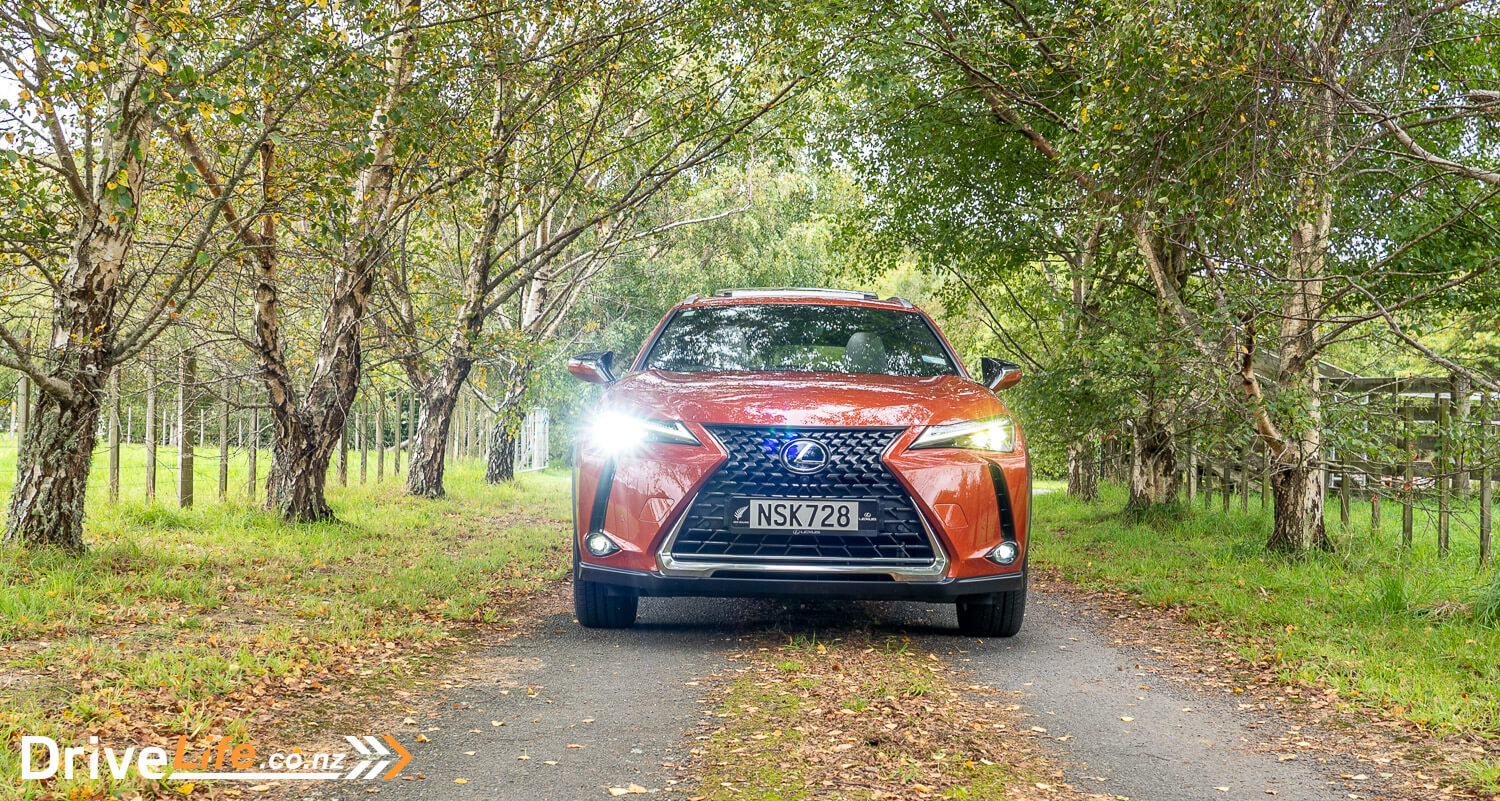
What We Like and Dislike About The 2022 Lexus UX300e Limited
| What we like | What we don’t like |
| Refinement High equipment levels Price Very low road and wind noise Design Quality of finish and fit Adaptive LED headlights Tight turning circle | Range could be better Touchpad Rear legroom CHAdeMo charging socket Low res display |
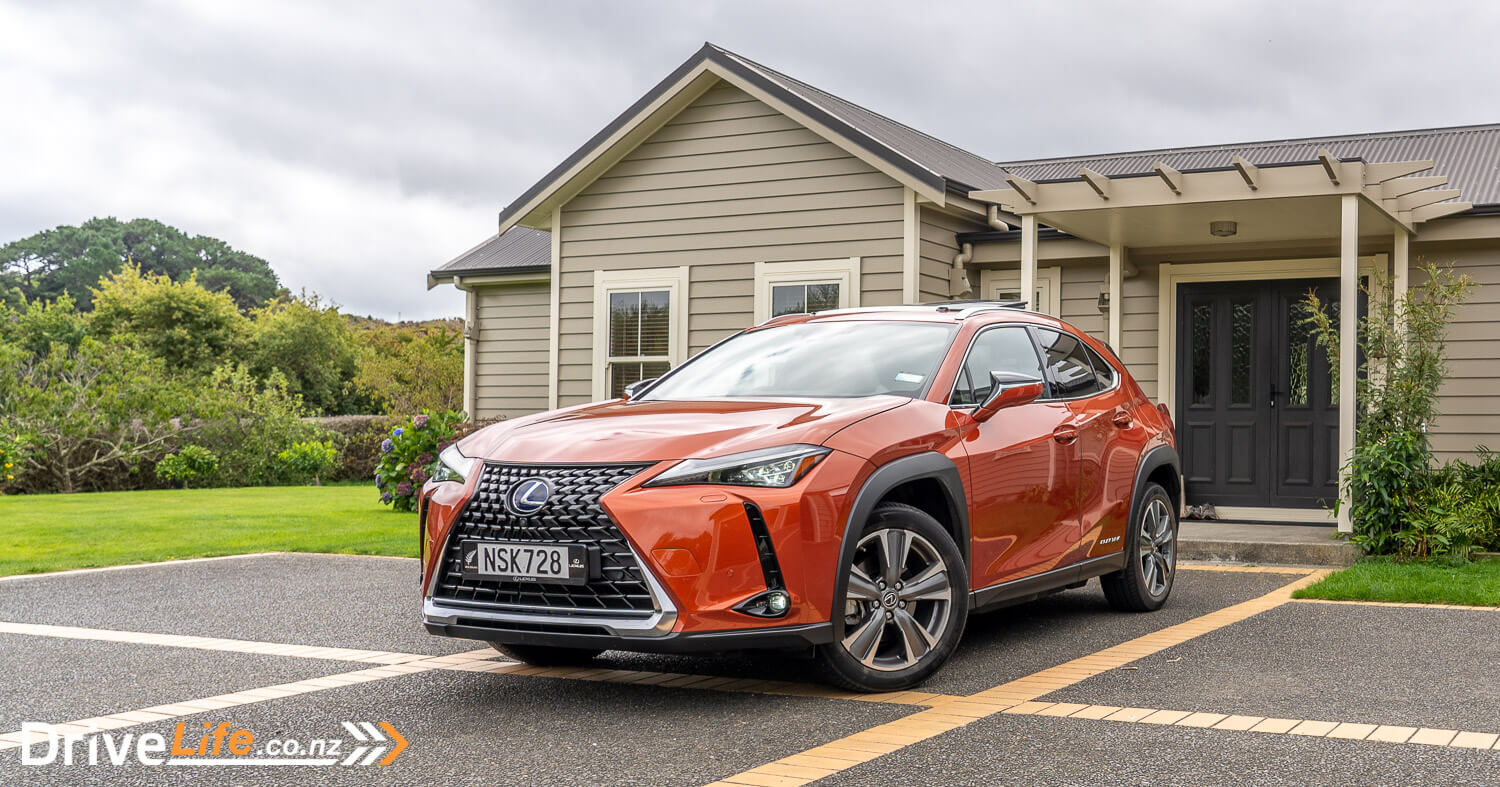
What’s In The 2022 Lexus UX Range?
With the addition of the 300e Limited, there are now 6 Lexus UX models to choose from:
- UX 250h $63,300
- UX 250h AWD $66,300
- UX 250h Limited $73,300
- UX 250h F Sport $73,300
- UX 250h Limited AWD $76,300
- UX 300e Limited (EV) $79,900
All the hybrid (h) models run a 2.0-litre, 4-cylinder petrol engine with a CVT transmission/hybrid setup, with a combined power output of 135kW and fuel consumption of around 5.0L/100Km. Torque is listed at 188Nm @ 4400rpm.
The 300e Limited is a full battery-electric vehicle (BEV), with a single electric motor providing 150kW of power and 300Nm of torque.
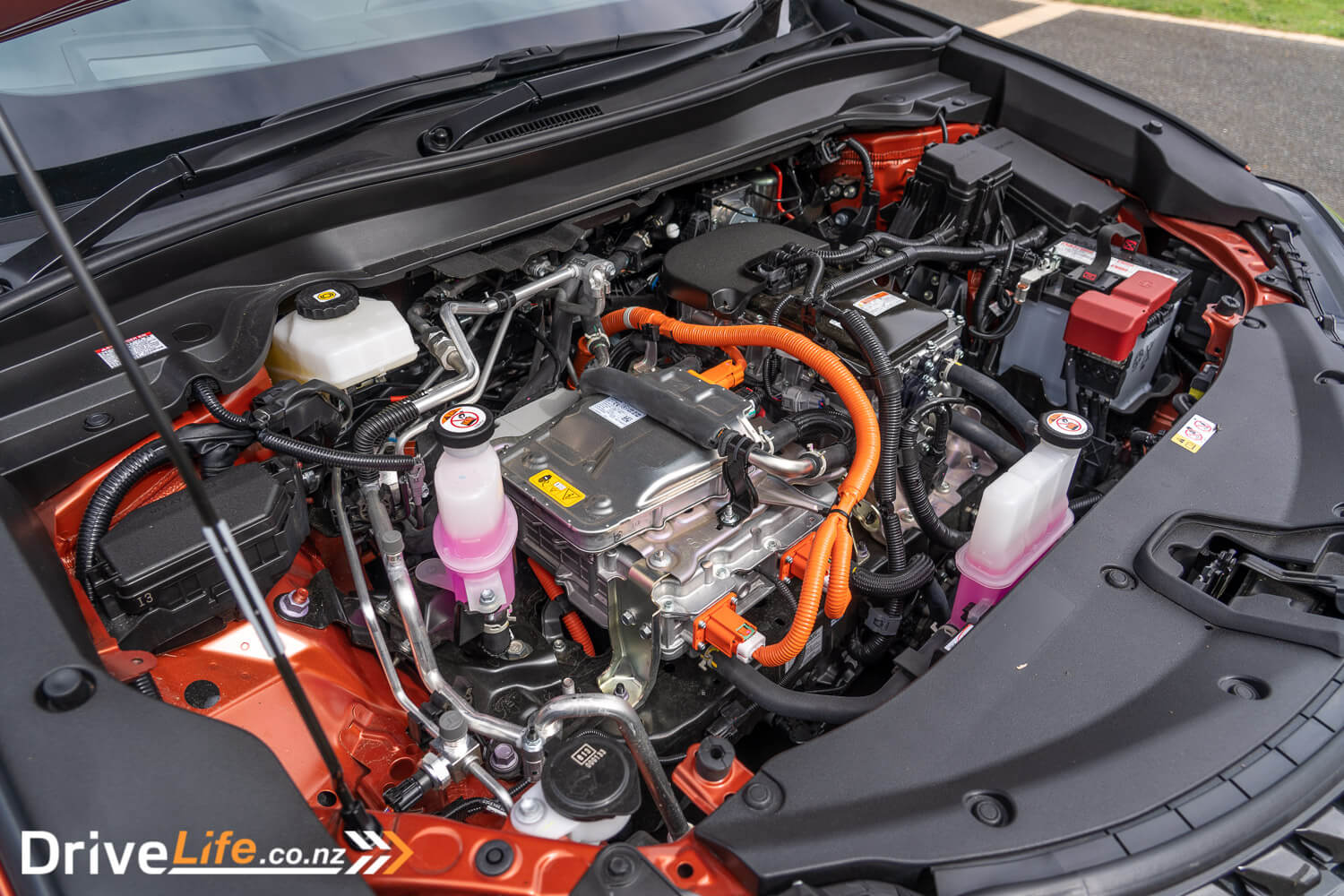
2022 Lexus UX300e Limited – Standard Equipment Highlights
- Pre-Collision System with Autonomous Emergency Braking
- Vehicle, Pedestrian Daytime and Night-time, Bicyclist Daytime Detection
- Lane Tracing Assist
- Lane Departure Alert
- Steering Assist Function
- Lane Centering Function
- All-Speed Dynamic Radar Cruise Control
- Adaptive High-beam System
- Road Sign Assist
- Panoramic View Monitor
- Intelligent Clearance Sonar
- Rear Cross Traffic Auto Brake
- Blind Spot Monitor
- Active Cornering Assist
- Emergency Stop Signal
- Traction Control
- Vehicle Stability Control
- Tyre Pressure Warning System
- ISOFIX points x 2, Tether Anchor x 3
- Smart Key Entry and Push Button Start, Lexus Card Key
- Engine Immobiliser, Siren Alarm, Tilt Sensor, Back Door Glass Break Sensor
- Block Mesh Spindle Grille
- Black Wheel Arch Mouldings
- Aluminium Roof Rails
- Sun Roof
- Acoustic Windshield and Front Door Glass
- Rear Privacy Glass
- 18” alloy wheels
- Hill-start assist
- Tri-LED Headlights
- LED Front Fog Lights
- Front Cornering Lights
- LED Daytime Running Lights
- Dynamic Auto Headlight Levelling
- LED Taillights
- Leather Shift Lever with Stitching and Satin Chrome Accents
- Power Adjustable Leather Steering Wheel with Heater
- Japanese Paper Grain Dashboard Detailing
- 7” Colour LCD Meter
- Colour Head-Up Display
- Leather Accented Interior
- Sashiko Quilting Detail on Front Seats
- 10-way Power Driver’s Seat Adjustment
- 8-way Front Passenger’s Seat Adjustment
- Front Seat Ventilation
- Front Seat Heating
- 60:40 Split Folding Rear Seats
- Outer Rear Seat Heating
- Dual Zone Auto Air Conditioning
- Rear Air Conditioning Ducts
- Rain Sensing Windscreen Wipers
- Auto Dimming Door Mirrors with Heater, Power Adjustment, and Auto Fold
- Auto Dimming Rear View Mirror
- Driver and Passenger Sun Visors with Mirrors
- Hands-Free Power Back Door
- 2 x Cup Holders in Centre Console, 2 x Cup Holders in Rear Seat Armrest
- Front Passenger Seat Back Pocket
- Wireless Device Charger
- 2 x Front USB, Auxiliary Input
- 2 x Rear USB-C Charging Points
- 2 x 12V Power Outlets
- Satellite Navigation with SUNA Traffic Channel
- Voice Recognition
- 3 Speaker Mark Levinson Premium Surround Sound
- 10.3” EMV Display
- Apple CarPlay and Android Auto
Our review car had no optional extras.
Colours are a reasonable mix of 9 options:
- Sonic Quartz
- Basalt Mica
- Sonic Shade
- Titanium
- Graphite Black
- Caliente
- Blazing Carnelian
- Terrane Khaki
- Celestial Blue
For a full list of specs and options available for the BRAND MODEL VARIANT head on over to the Lexus New Zealand website.
How Does The 2022 Lexus UX300e Limited Compare To Its Competition?
It wasn’t that long ago that the Hyundai Kona would be the only EV SUV on the table. Now, you have options.
| Make/ Model | Battery Capacity kW-hr | Power/ Torque kW/Nm | 0-100km/h seconds | Range (WLTP) | Boot Space, litres | Price |
| Hyundai Ioniq 5 Elite | 72.6 | 225/605 | 7.4 | 481 | 527 | $96,990 |
| Kia Niro EV Premium | 64 | 150/395 | 7.8 | 455 | 523 | $85,990 |
| Hyundai Kona Electric Elite 64 kWh Series II | 64 | 150/395 | 7.6 | 484 | 332 | $85,990 |
| Mercedes-Benz EQA | 66.5 | 140/375 | 8.9 | 400 | 340 | $85,500 |
| Lexus UX300e Limited | 54 | 150/300 | 7.5 | 360 (NEDC) | 310 | $79,990 |
| BMW i3 | 42 | 125.NA | 7.2 | 260 | 260 | $78,700 |
| Mazda MX-30 | 35.5 | 107/271 | NA | 224 | 341 | $74,900 |
| Tesla Model 3 Rear-Wheel Drive | 54 | 211/375 | 6.1 | 491 | 649 | $74,443 |
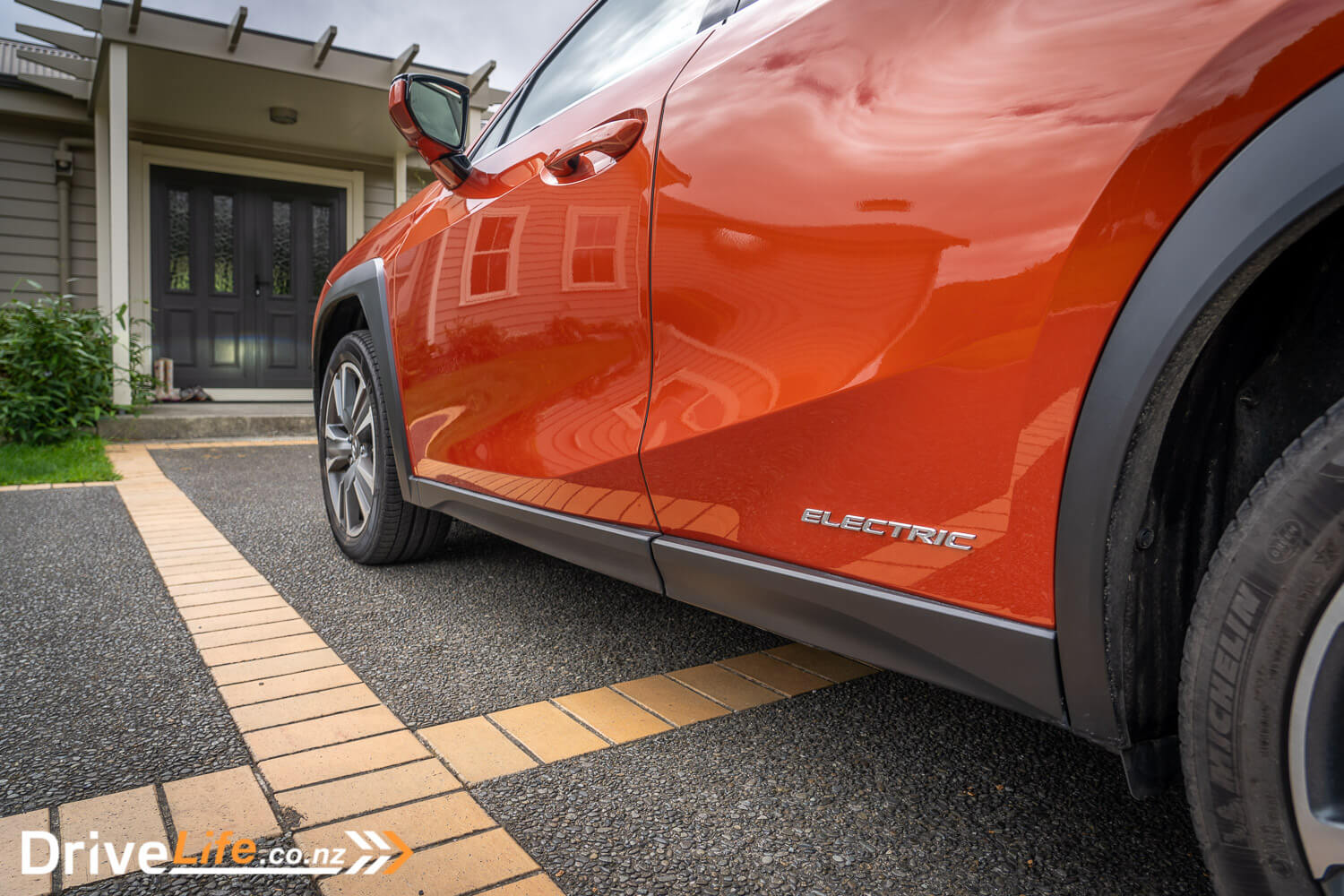
First Impressions Of The 2022 Lexus UX300e Limited
Fears of getting a test car in silver or grey be gone – our test UX300e was finished in Blazing Carnelian, and it looked excellent. Actually, it was painted the same colour as the UX250 F Sport I tested in 2019. Yes, the grille is enormous but in the flesh, it doesn’t look so bad.
There’s almost no departure from the current UX design; there’s the normal huge front grille, but it’s mostly blanked off. So the front of the car hasn’t taken on any weird design traits, and for that I’m thankful.
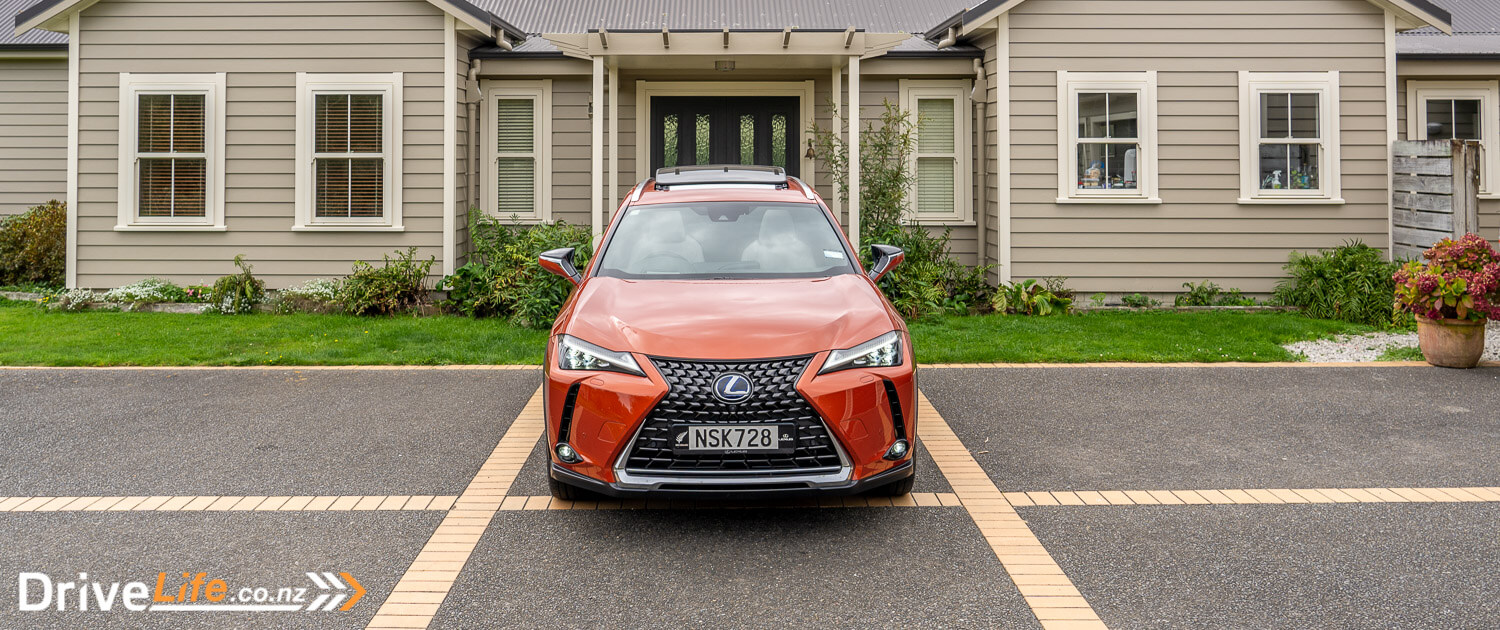
In fact, other than having two ‘fuel filler’ flaps, the whole car looks exactly the same, except for some small “ELECTRIC” chrome lettering on the rear doors. All very subtle, and no doubt feeding into the needs of the Lexus buyer who doesn’t want something outlandish or spacey. The Lexus UX300e looks good.
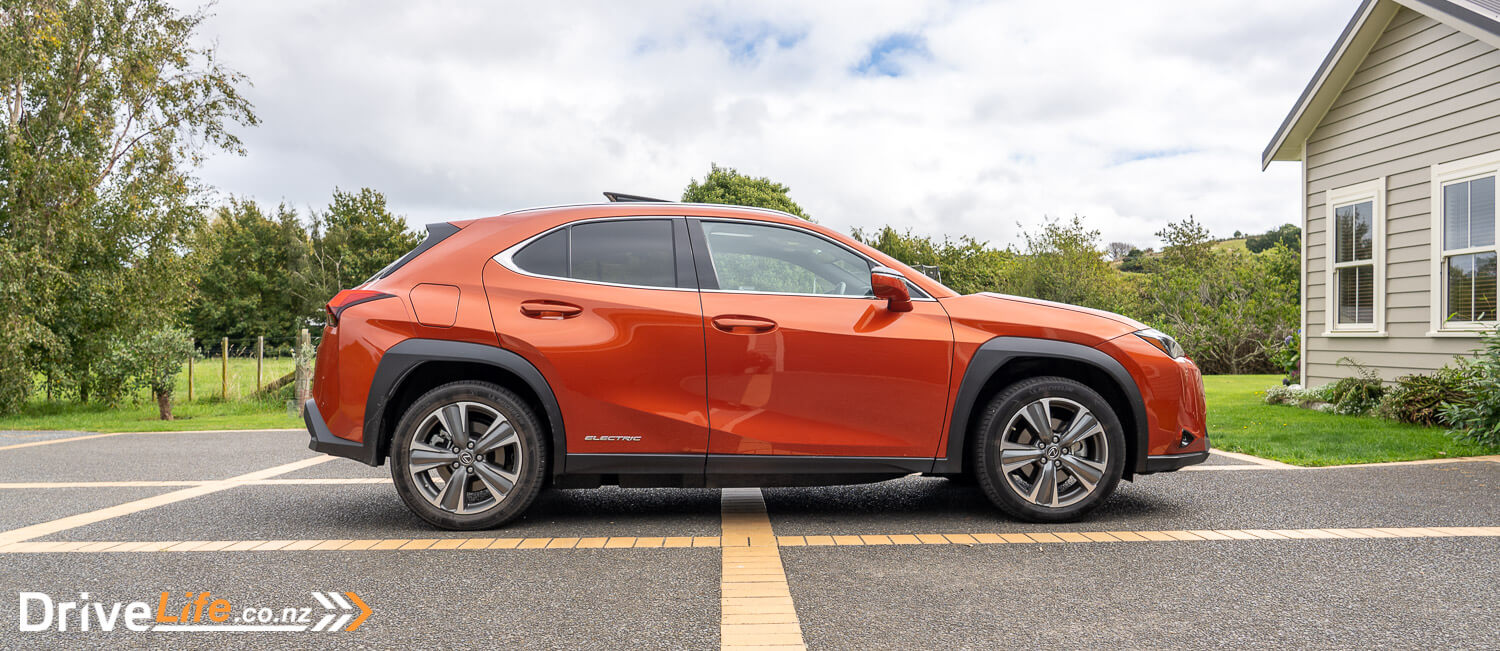
What’s The Interior Like In The 2022 Lexus UX300e Limited?
Getting in the car, there are some nice, white leather seats as well as white used on the door armrests and console. It really lifts the interior of the car and is a world away from having everything black. Lexus has stuck in a black headling but overall the interior is nice and light. There are some nice options around interior colours for the UX3003 Limited – Rich Cream, Ochre, and Zephyr Blue – and all three are accented with Sashiko quilting on the front seats.
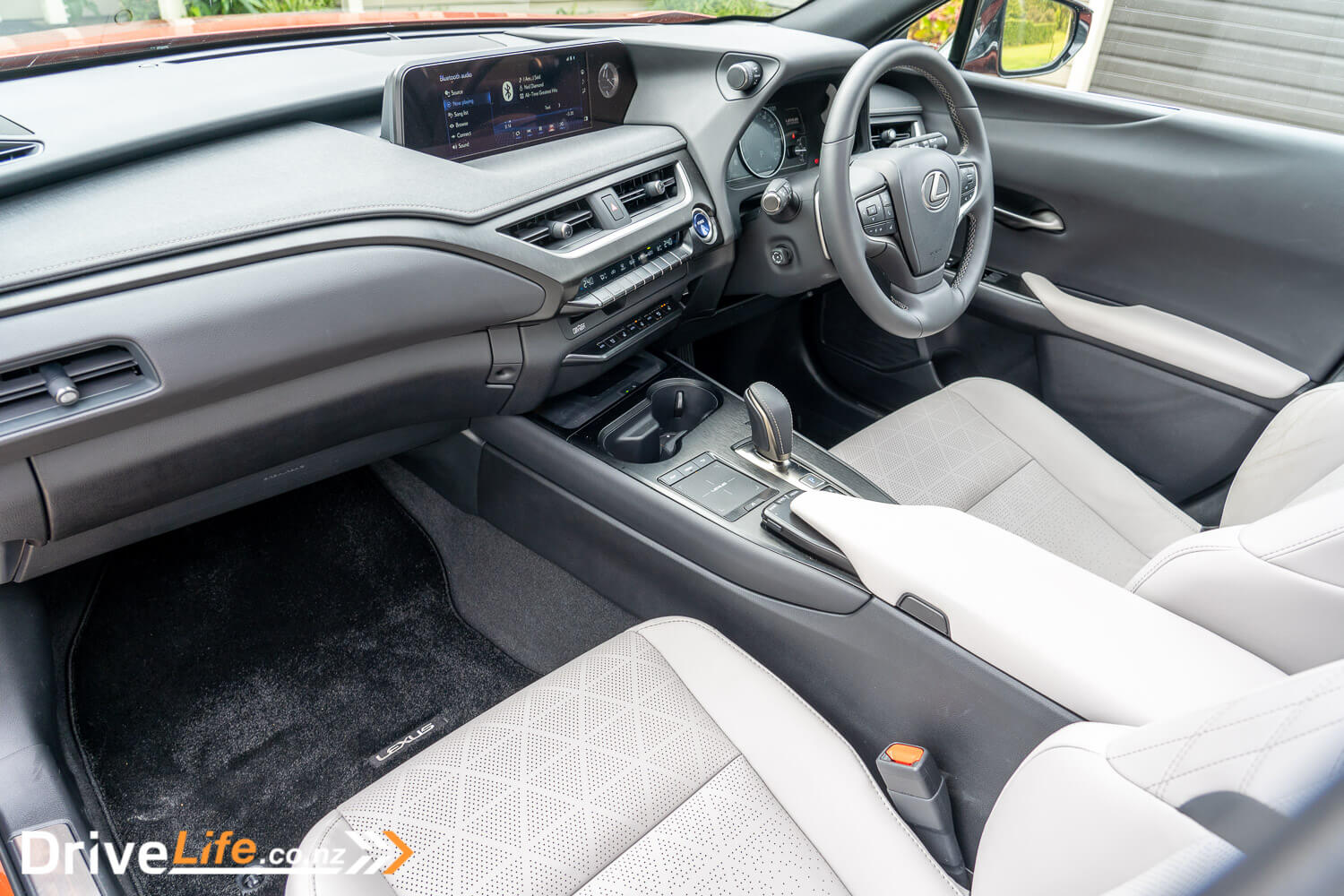
The tilt/slide electric sunroof helps here, just having the (manual) blind open lets in a good amount of natural light.
The centre screen isn’t a touch unit, but it is mostly integrated into the dash so doesn’t look too much like an afterthought. There, on the right side of the screen itself is Lexus’ tradition – the analogue clock. After a few days in the car, I came to appreciate this more than having a digital clock somewhere on the side of the centre screen.
Another common Lexus feature is down there on the centre console, a touchpad. Honestly, touchpads in a car simply don’t work. It’s hard to get the pressure right while on the move, and selecting items on the screen takes more time and concentration than it should. On the rear of the centre console is a smallish cubby. It opens from either side of the car which is a cool thing to watch working.
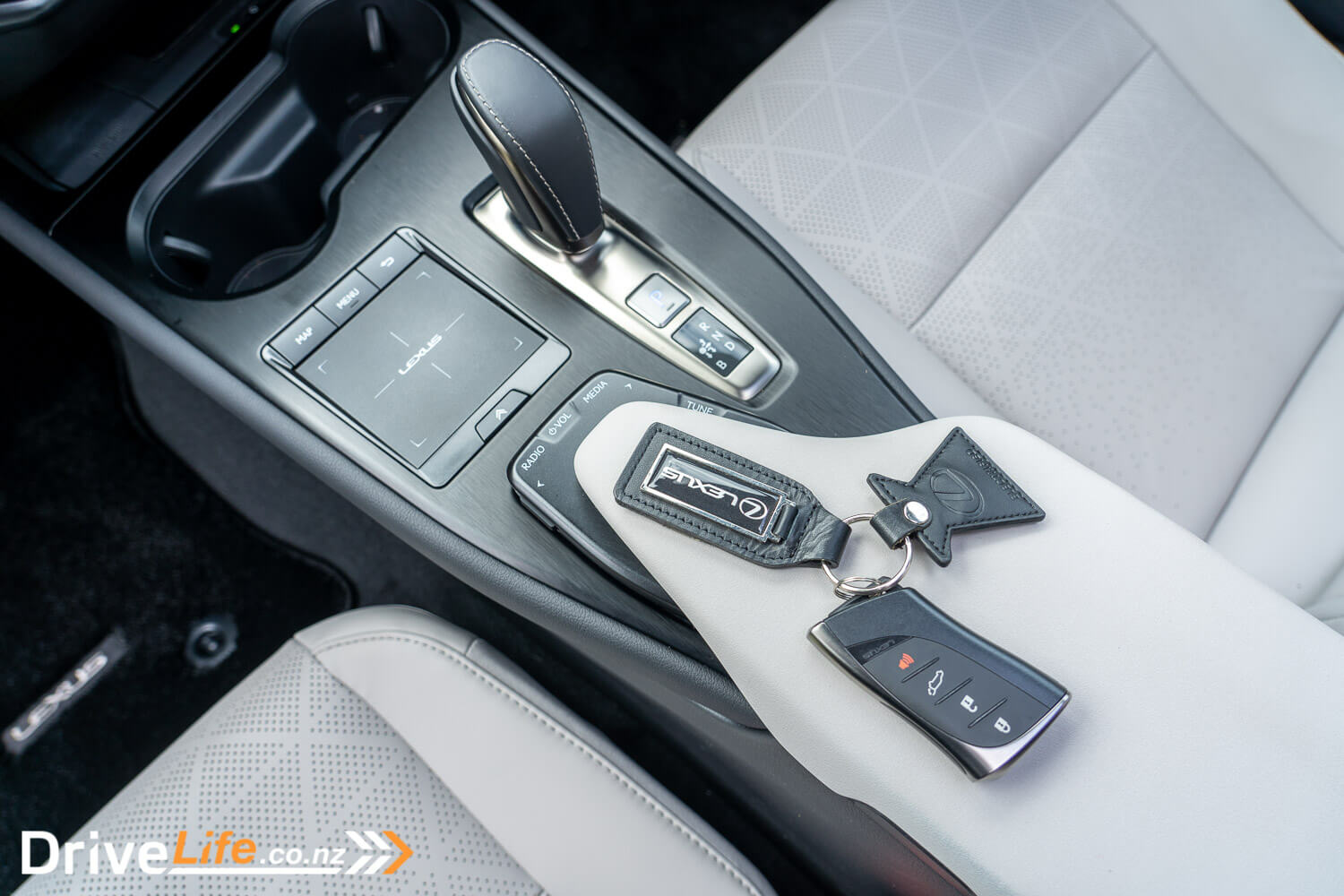
Up front is a Qi wireless phone charging pad, and above that is a CD player. Yep, you can still play CDs in your electric Lexus. Up on top of the dash are some very nice fabrics; in fact, as you’d expect, the whole interior is a mix of premium fabrics and materials, and fit/finish is top class.
I mentioned the equipment levels in the opening of this review, and really, there’s not a lot missing. Heated front and rear seats, ventilated front seats, 360-degree camera, electric tailgate, adaptive cruise control, adaptive LED headlights, 2-stage heated steering wheel, electric sunroof – and there’s more. This car has all the things I find either necessary or desirable, at a very reasonable price point.
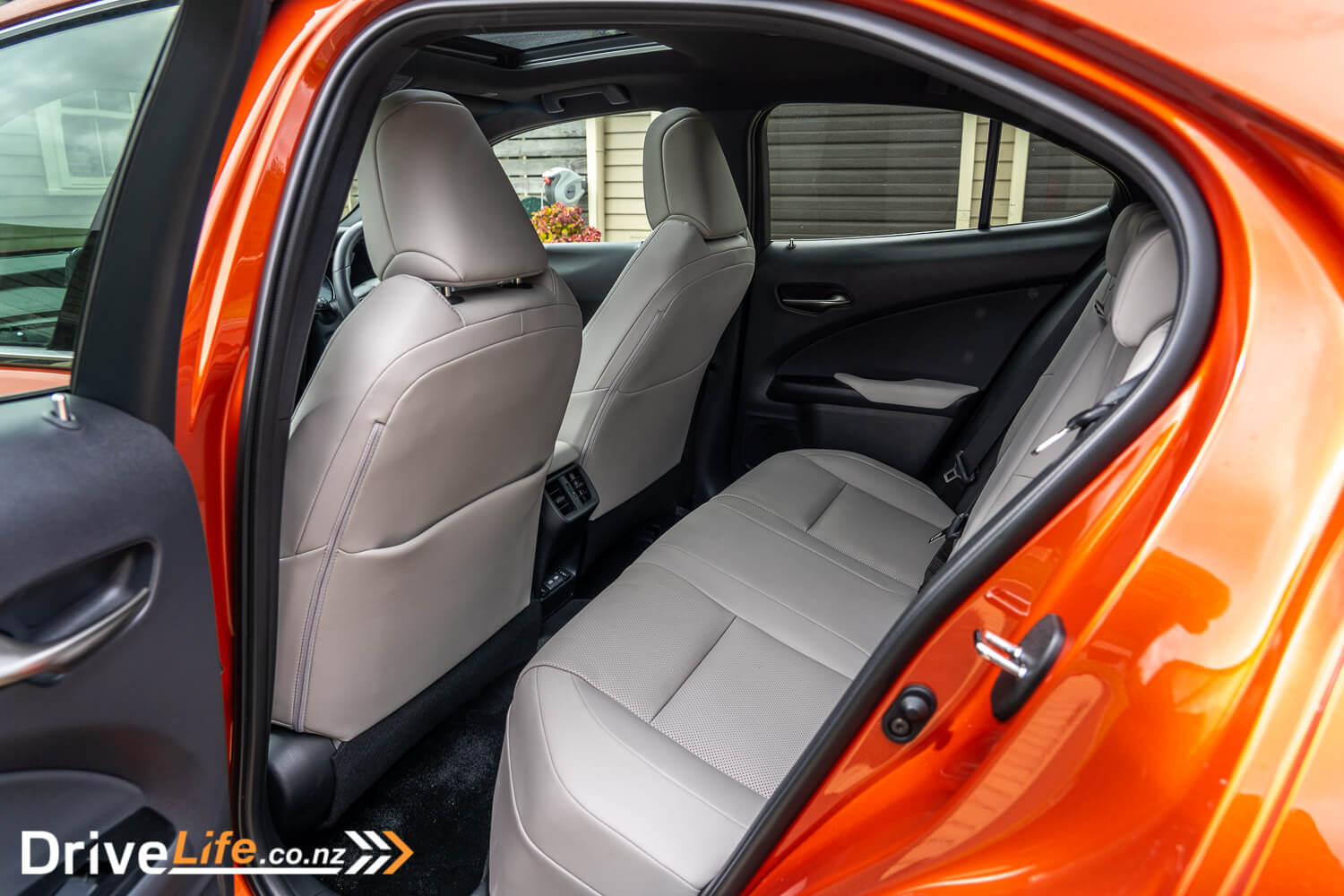
Rear legroom is fairly tight, but rear-seat passengers do get heated seats back there. Entry to the back seats is also tight, with passengers having to duck heads a little. Headroom is average for the class.
The boot is just over 40 litres bigger than the petrol model, due to the removal of the fuel tank. It does feel usably larger, at 310 litres total with the rear seats up. There isn’t any sort of spare – there is a tyre pump instead.
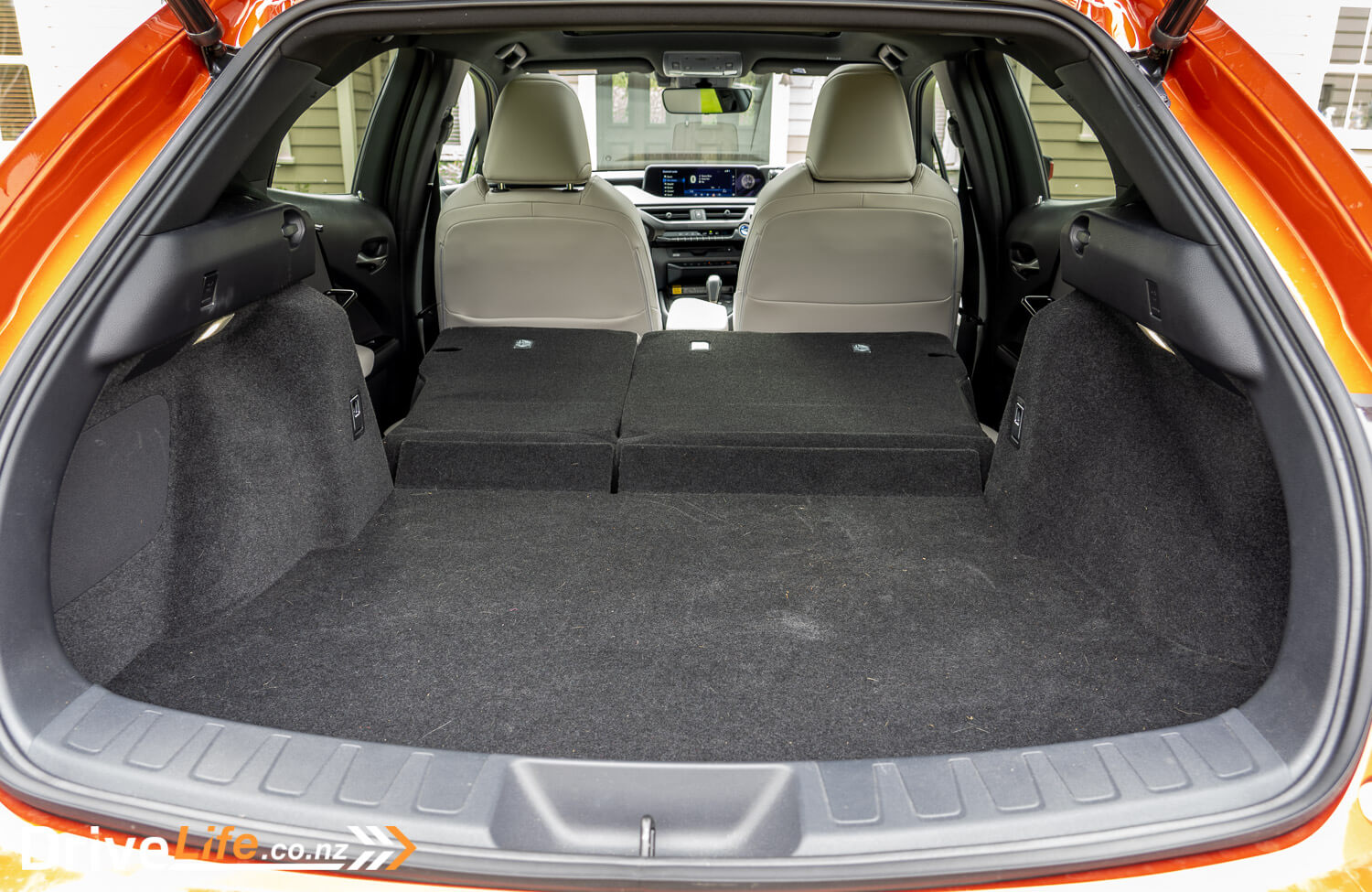
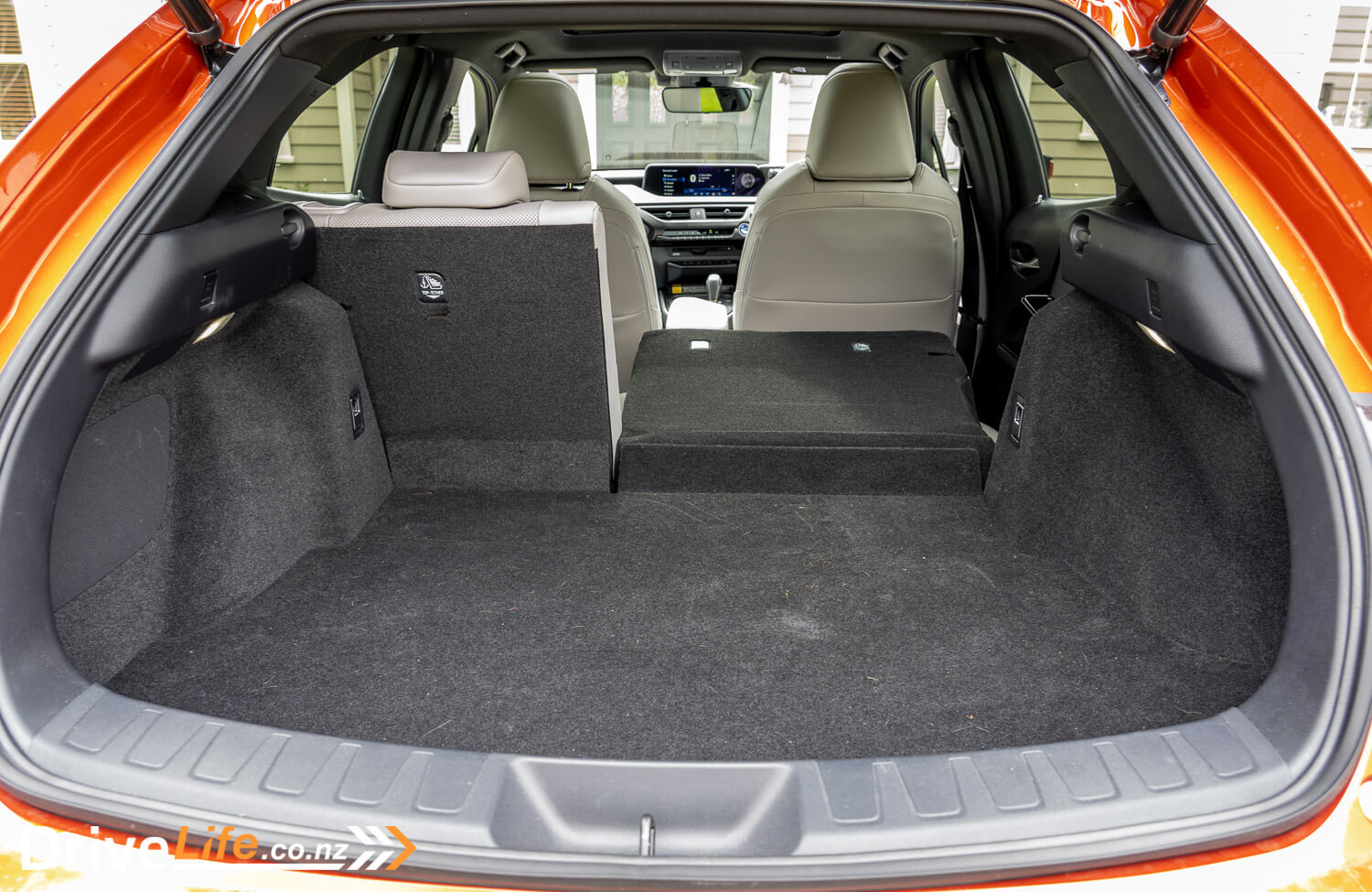
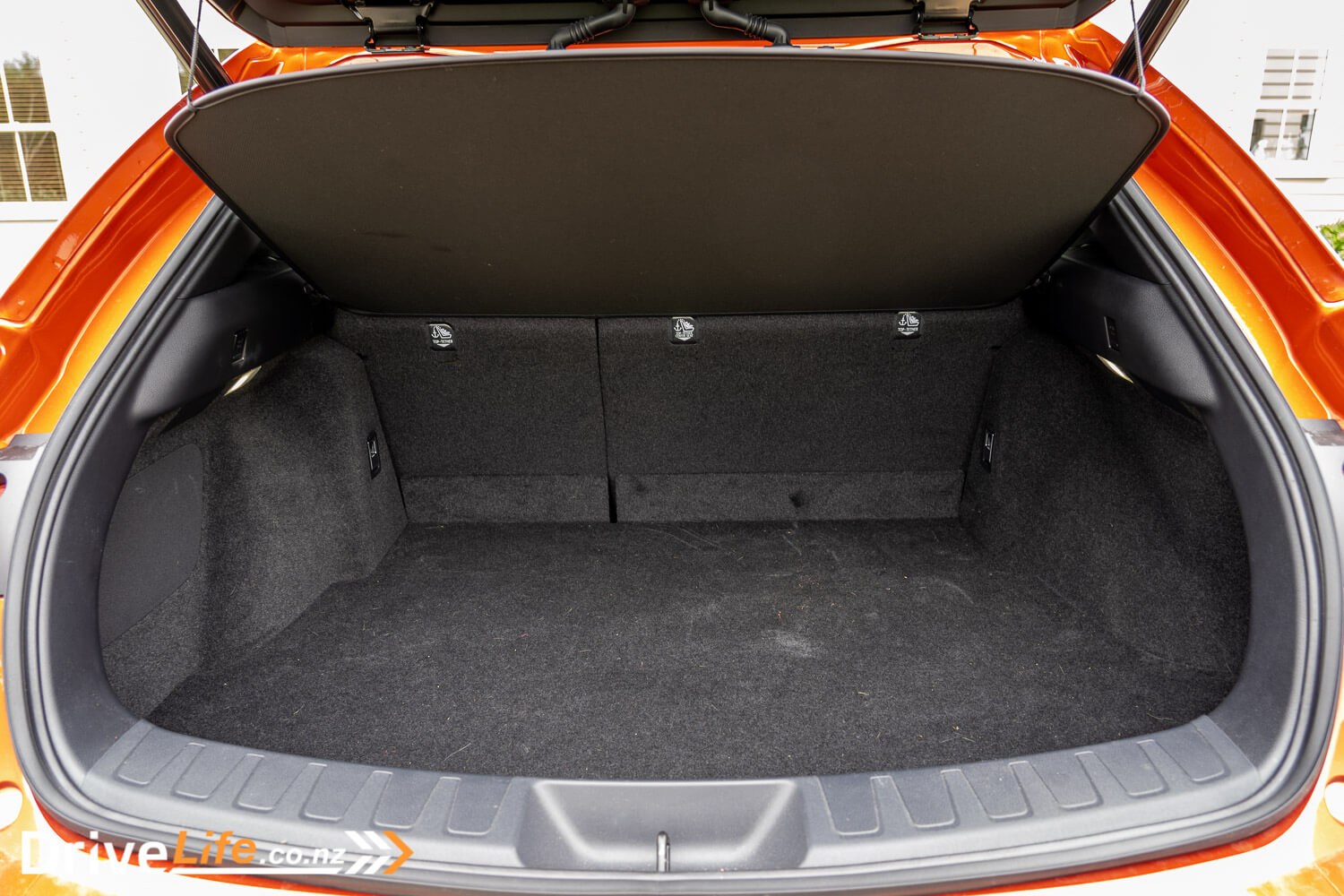
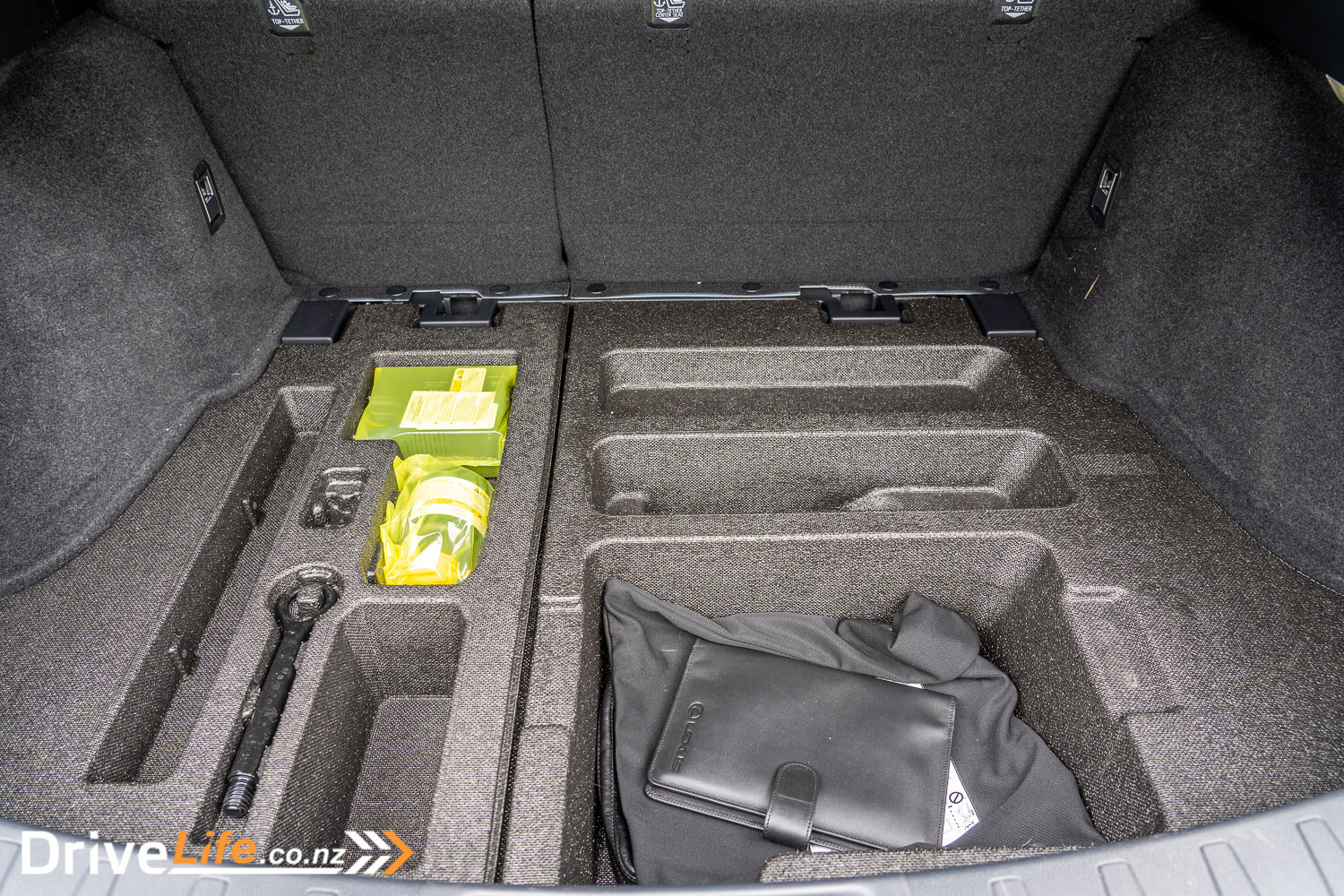
What’s The 2022 Lexus UX300e Limited Like To Drive?
Picking up the car, immediately I’m reminded it’s an EV; most EVs are very quick off the mark, as all that torque kicks in as soon as you mash the accelerator pedal. The UX300e is no different here, and with 150kW of power and 300Nm of torque on tap, it really gets away from the lights without hesitation, although you can feel the steering wheel pulling a little at times since it’s front-wheel-drive only. The car will accelerate to 100km/h in 7.5 seconds.
Either side of the steering wheel are the brake regen paddles; You get 4 regen levels to choose from, and there’s the normal “B” mode using the gear level as well. This will add in some extra brake regen. While driving the car over 1,000Km, I used the paddles consistently to achieve a smooth reduction in speed while getting that extra bit of charge in the batteries. The paddles are perfectly placed to achieve this.
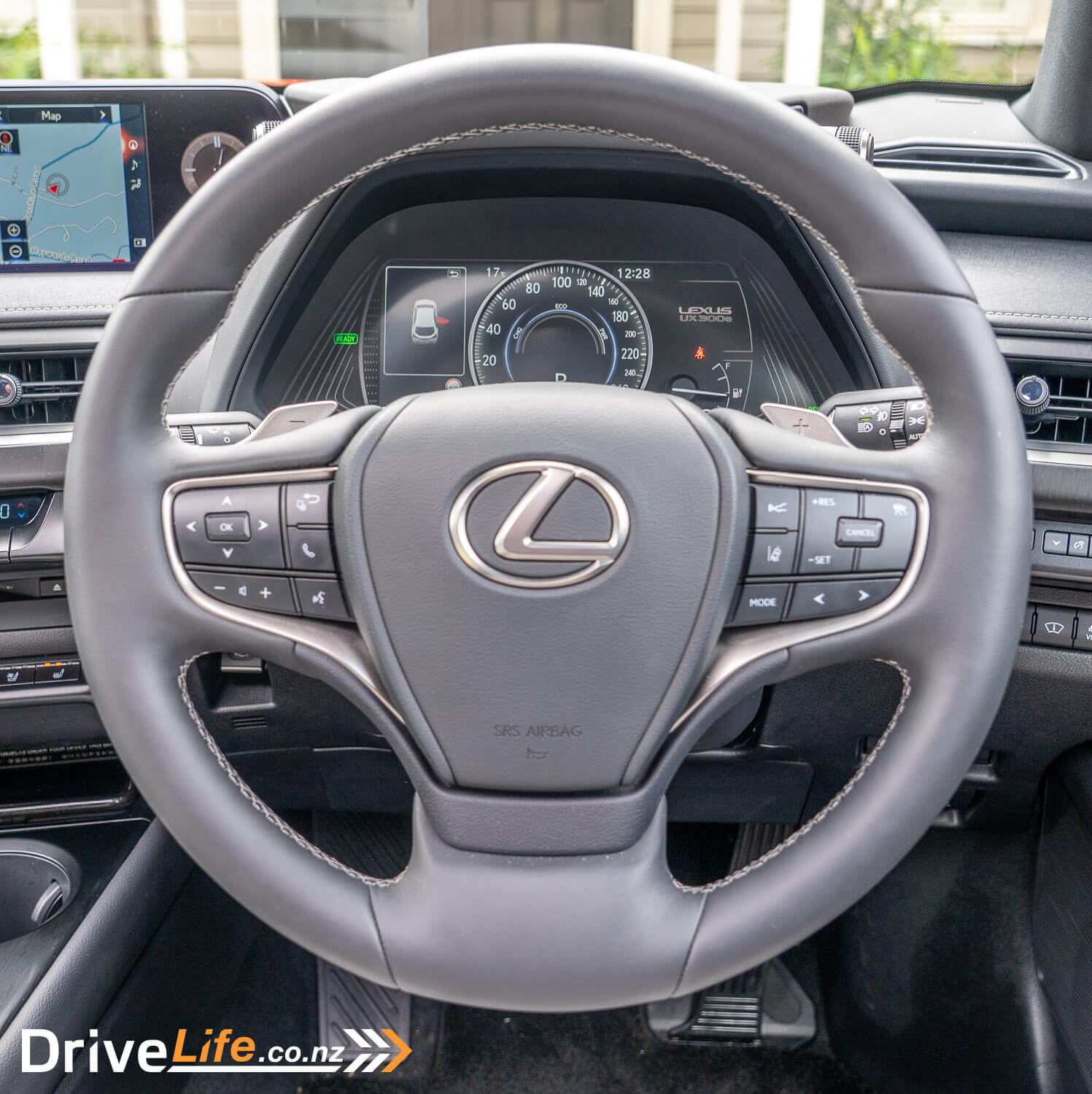
My first decent trip in the UX300e was a cruise over to Masterton and back, around 220km of driving. With an NEDC rating of 360Km, this shouldn’t be too hard. Leaving home with the battery fully charged (and the display showing 300km of range) and driving in the rain, we got to Masterton with a little over half charge left. There are a few things with the battery indicators on the UX300e we need to talk about. The first is that while the whole dash is essentially digital, there is also an old school analogue ‘fuel’ gauge. I say fuel gauge because that’s exactly what it looks like. There’s even a little fuel pump icon with an electric plug on the side of it. So this is your indicator of how much charge is left in the battery bank, as there’s nothing else. On the centre screen? Nothing – no EV diagrams, no battery monitors, no range shown.
Your range remaining is shown on the dashboard right in the middle, so that’s handy. But something more would have been much appreciated.
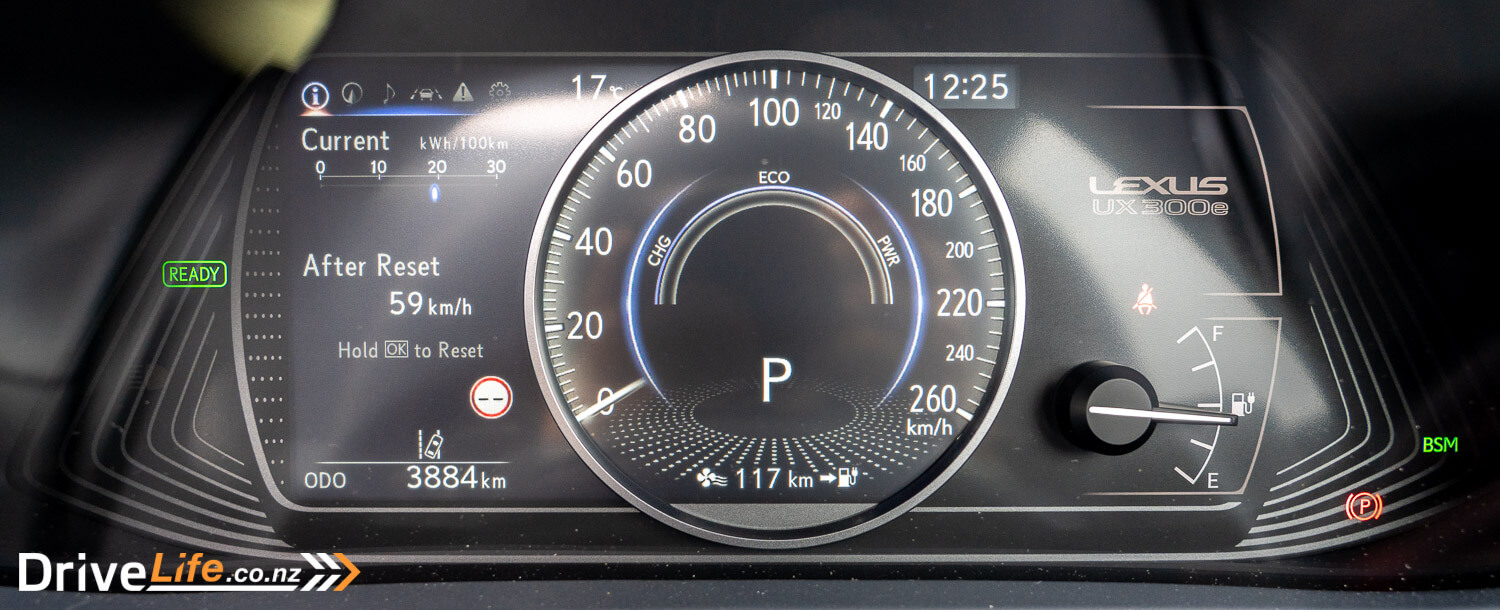
The rain did show that the UX300e will spin its wheels very easily, and this was really evident on the Remutaka Hill; a good prod of the right pedal got the front wheels to lose traction, but nothing dangerous.
Regardless, we did what we had to do in Masterton, and then headed home, still raining. Rain or a wet road will suck more range out of your batteries, as the drag of the water means you are using more power than you would need if it was dry.
Without telling my wife, our range did go down quicker than I wanted to, but hey, we made it home with 29km of range still left, so that’s a win. What does that mean in real-world terms? We would have got 250km out of the UX300e. Did it matter? Not really. For that trip, we did what we needed to do, so no drama. Generally, if I wasn’t testing an EV to see how far it would go we would have charged it up a little in Masterton anyway, maybe spending ten minutes to give it a quick top-up. It’s not hard and you adapt what you are doing to allow for things like this. It’s a great time to go grab a coffee while the car is charging, and stretch your legs.
So what’s this NEDC rating of 360Km for the UX300e Limited, when most other manufacturers use the more common WLTP rating? The NEDC test is shorter than the WLTP one, and so the suggested range is going to be more accurate and more real-world under WLTP than NEDC. One WLTP figure for the UX300e Limited is 315km, so our 250Km real-world test is some 20% less than that. Lexus NZ only suggests the NEDC figure of up to 360Km.
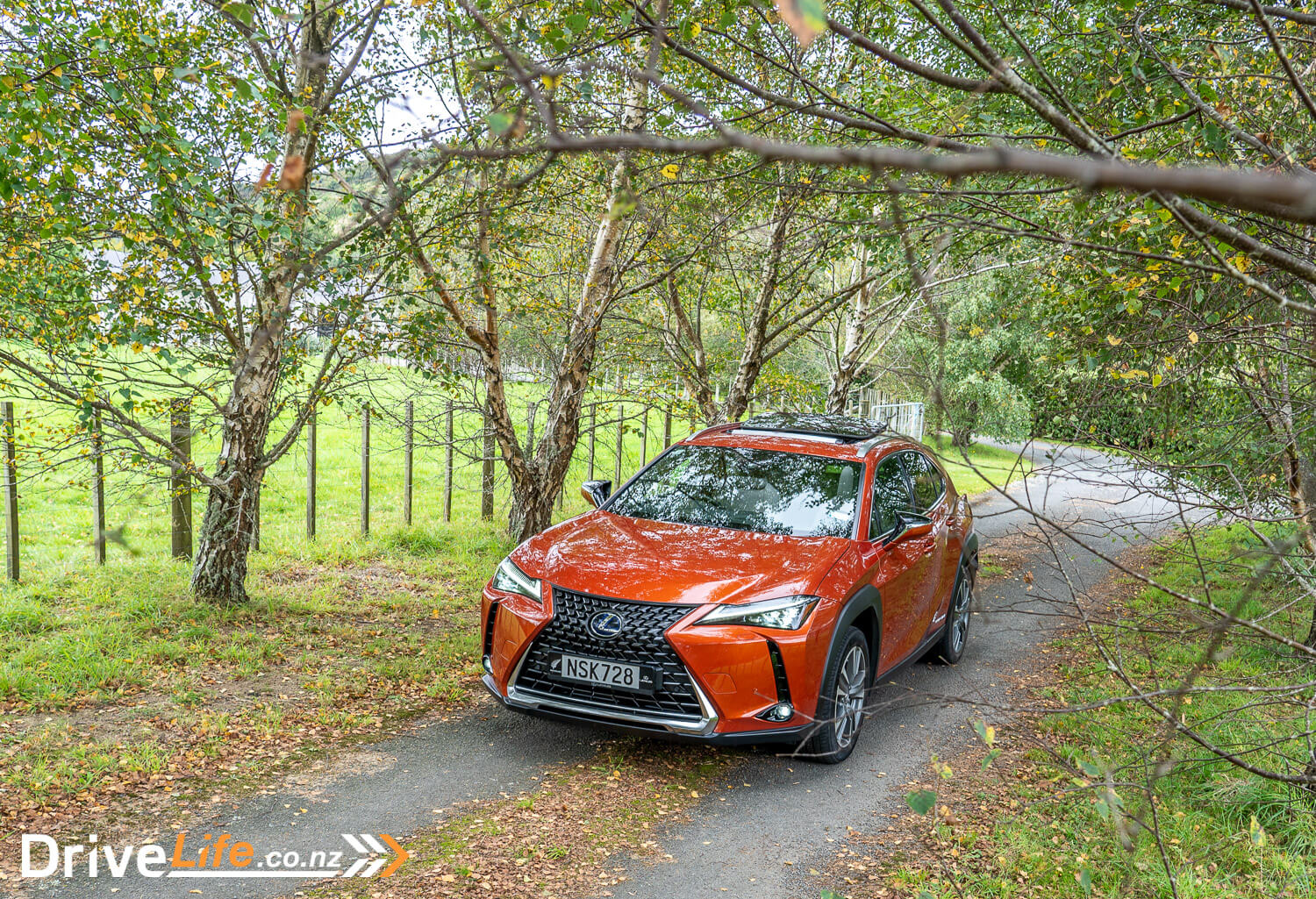
Naturally, the car does have an Eco mode and with the torque of an EV, it’s an extremely easy car to drive in Eco. The accelerator pedal gets a bit harder to press down, but there is so much performance available, you can leave it in Eco mode all day long. Well, until you get out of the car, then it reverts to standard mode.
Like the previous model I tested, the EV version of the UX still has those knobs way up high on the instrument binnacle. These still puzzle me; the one on the left does your drive modes, and the one on the right turns traction control off or on. Why you would want such easy access to traction control in a Lexus UX is a question that will likely go unanswered.
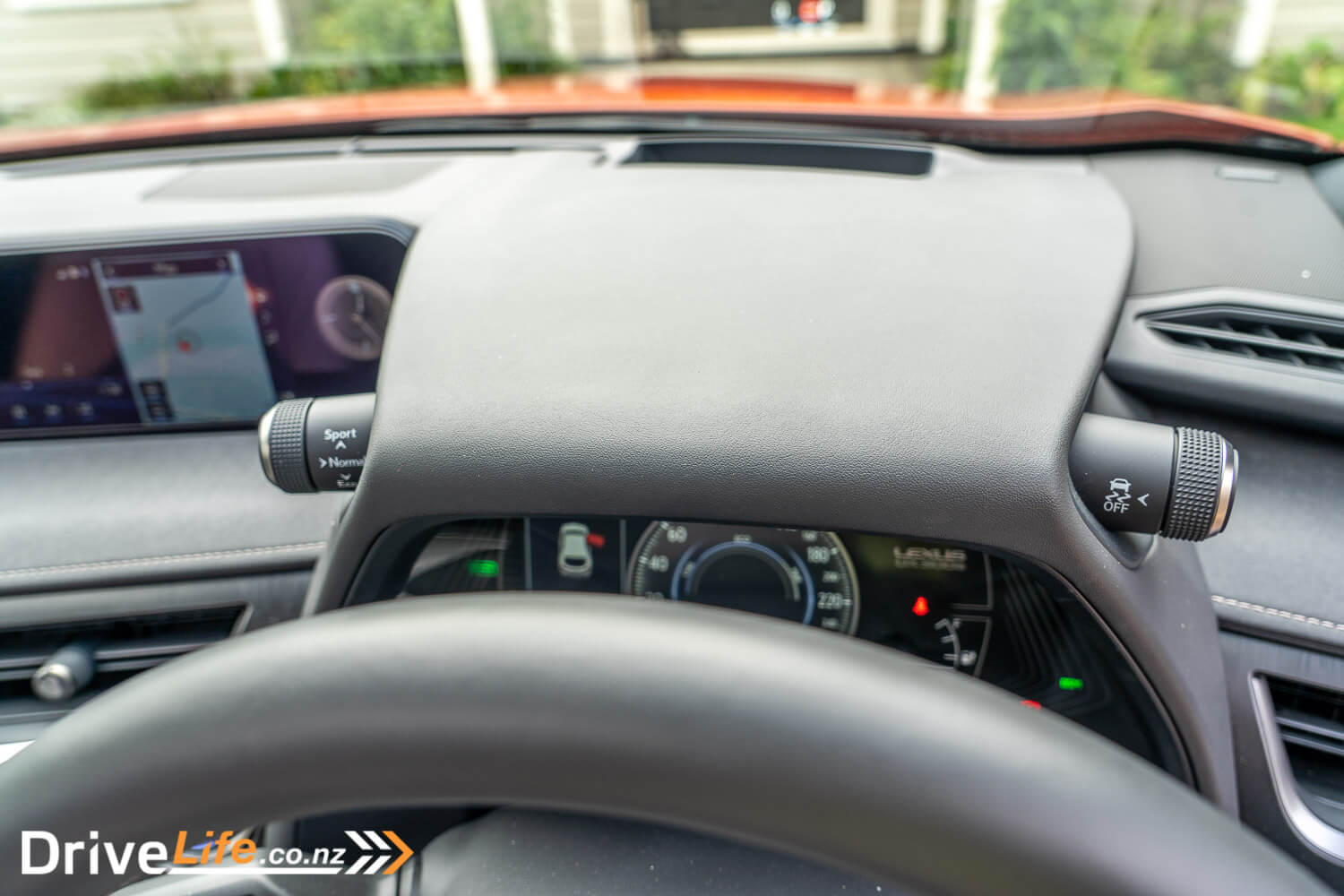
Above the binnacle on the windscreen is a standard Lexus heads-up display (HUD), It works well and shows your current speed, the current speed limit, SatNav directions and media info. It also has a power-bar gauge on the bottom, showing you if the car is charging, if you are driving economically, or if you are using more power. I must admit, with it right there on the windscreen, it did help me to make better decisions around how hard I was pushing the gas pedal down. The same power-bar gauge is there even when the UX300e is in Sports drive mode.
It was time to do trip #2 in the UX300e Limited – Wellington to Hawera and back, just under 600km so a perfect test for the car. I’d be heading to Hawera to work on our project car, spending Friday-Sunday there and then returning to Wellington.
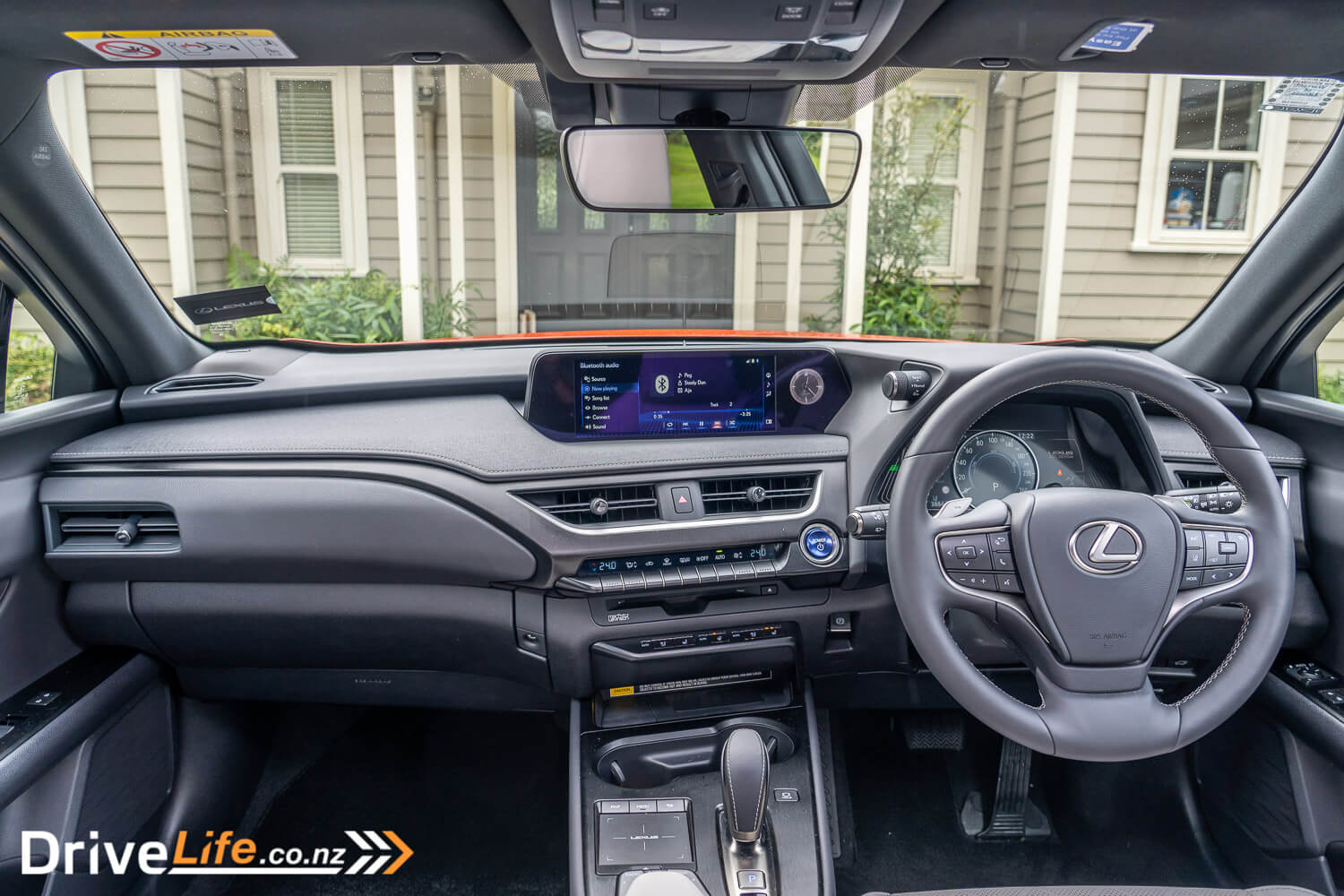
Leaving home early on a Friday morning with a full 300Km charge, and it’s time to take in the UX300e while driving. It has some excellent points in its favour. For example, the ride quality is brilliant. Yes, the car weighs in at over 2200Kg and that has to help, but the ride is very smooth regardless.
It’s also extremely quiet, even for an EV. Wind noise is pretty much nonexistent, and road noise is very well subdued. Those Michelin Primacy 3 tyres can get noisy – especially on coarse chip seal – but we’ve struck this issue with those same tyres on other EVs. Having the sunroof open on the open road is not too bad, with an acceptable amount of buffeting coming into the cabin. There’s a pop-up wind deflector to help things in this department.
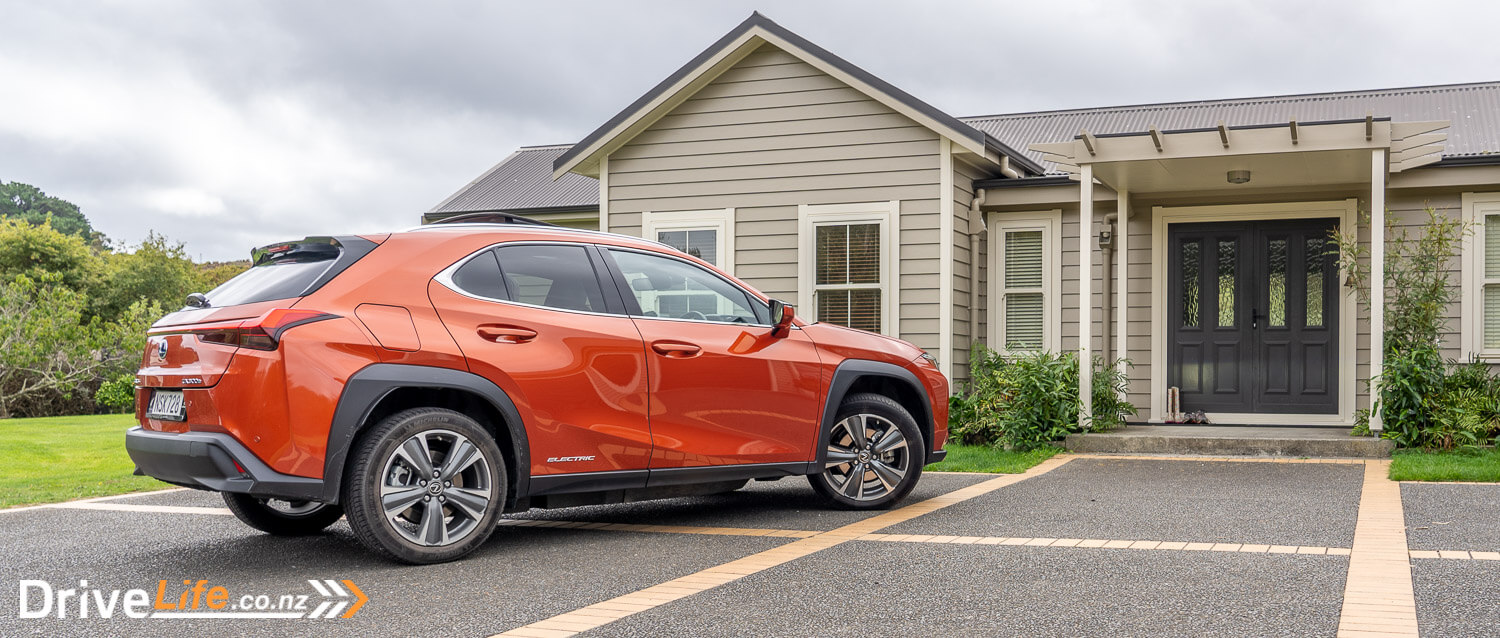
The general refinement of the car is superb, and it’s a very easy car to live with on a long trip. The seats are comfortable, with just the right amount of padding for a few hours behind the wheel at a time.
On the ‘not so good’ front, the resolution of the central screen is very low. Lexus is getting left well behind here, with other manufacturers having crisp and clear screens with high resolutions, while Lexus is certainly not. You could of course use Apple CarPlay or Android Auto, but regardless, Lexus is still behind the 8-ball here and has been for some time.
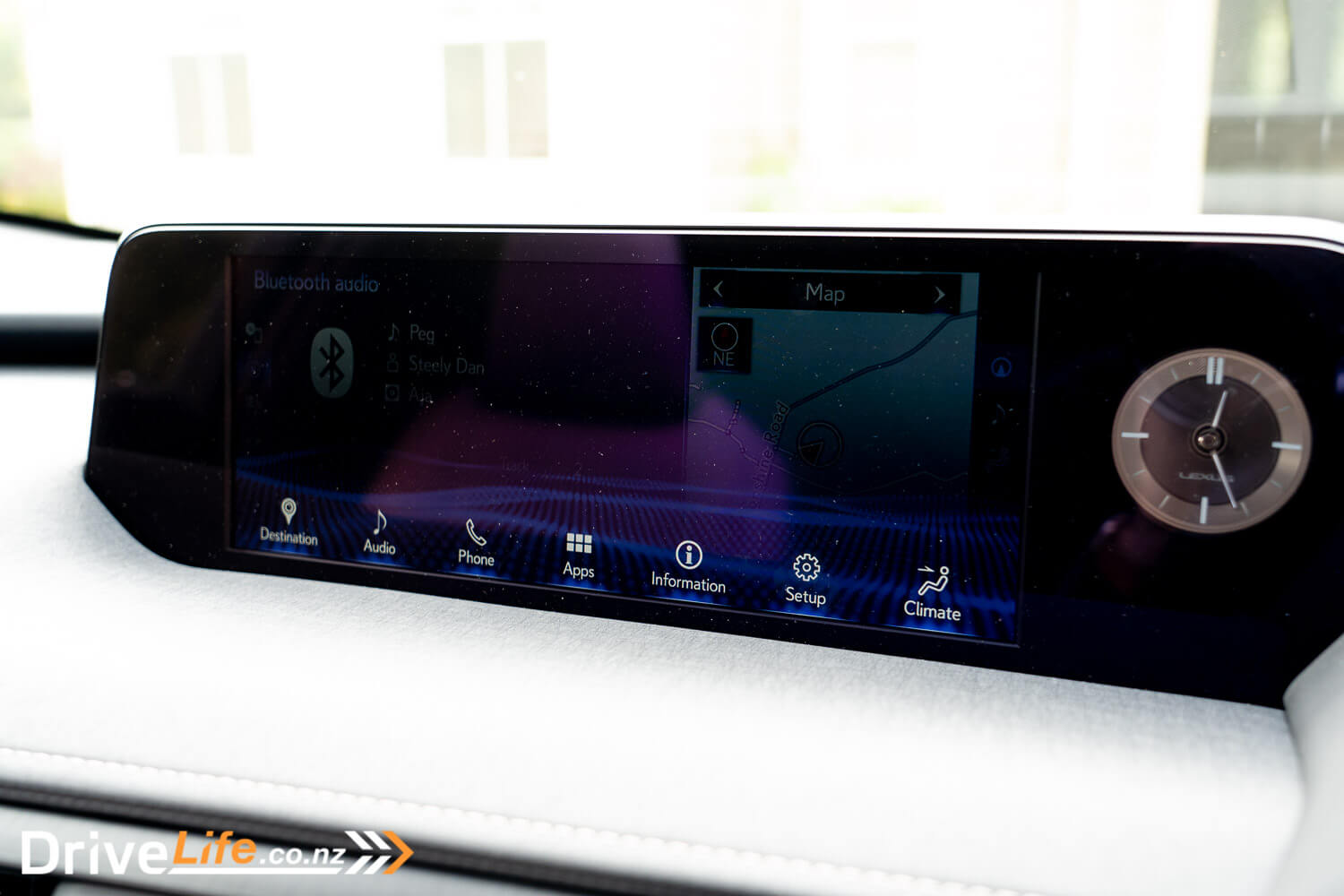
Traffic sign recognition is also a bit dodgy, at times simply missing changes in the speed limit, so the sign showing on the HUD may not be correct “But, officer…”.
By the time I got to Whanganui, it didn’t look like I was going to make it to Hawera so instead, it was a stop in at the Chargenet charger by the Pak N Save. I got there with 69km range left and had 90km to go. Fifteen minutes later, I had easily enough charge to get going again. While those filling up with petrol might scoff at a 15-minute charge time, it went very quickly.
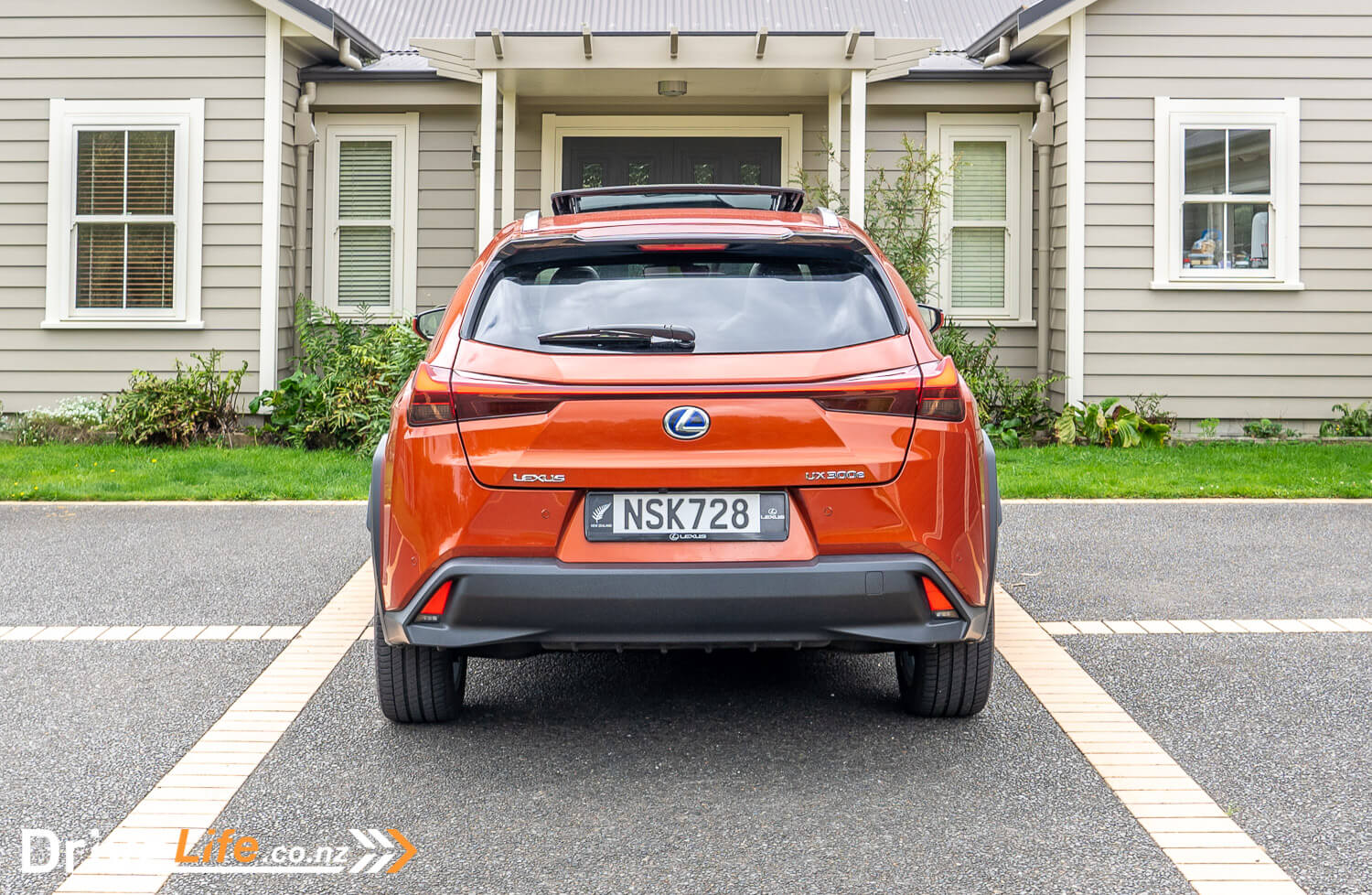
This does bring up a negative for the UX300e however; it is fitted with a ‘CHAdeMo’ type of charging socket, so the car is limited to 50kW of input charge. This means that you can’t plug this model into a Hyper or Super Charger. For most people, this won’t be an issue but it does show how Lexus has managed to use air-cooled batteries instead of liquid-cooled. CHAdeMo is commonly used by Nissan Leafs, while most other manufacturers have moved to a ‘CCS Type 2’ charging port, that can take far higher rates of charge. Since most people charge at home, this shouldn’t be an issue, but it’s something to keep in mind.
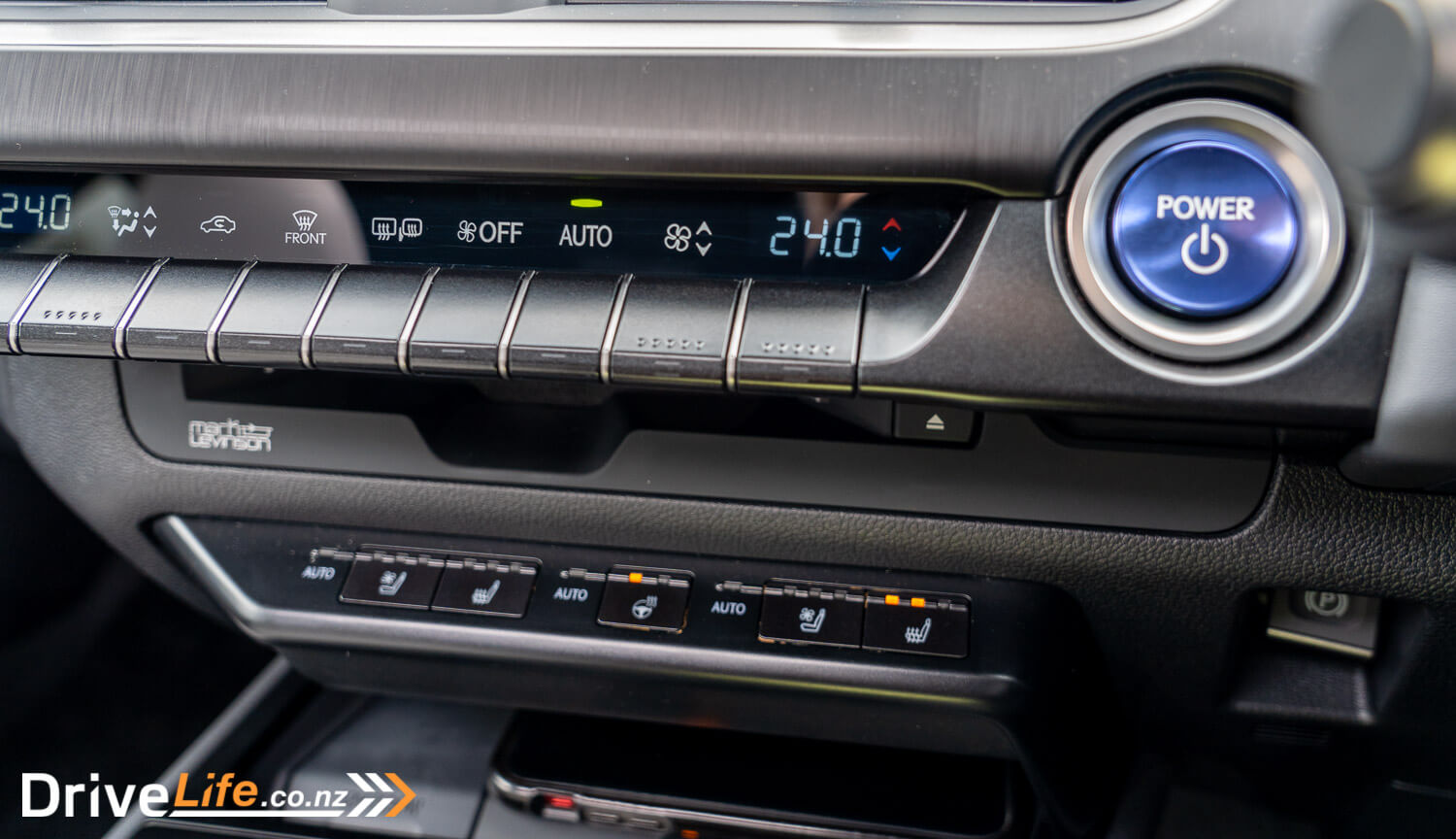
Using a CHAdeMo port is the way Lexus has managed to avoid using liquid cooling for the batteries, and instead relies on its experience with hybrids and air cooling. The batteries do have a heating element, so if the temperature is too low, the heating element will bring the batteries up to 15 degrees for better charging.
I mentioned the UX300e not having any sort of display to show what’s happening on the EV side of things, and this is the case when charging, too. When you plug in a fast charger (or plug it in at home), an icon appears briefly to show you what level the battery is currently at. There are no numbers on it, so it’s just a quick look and then a guess. While the car is charging, you have no idea when inside the car how much longer it will take. Your options here are to turn the key on to ignition now and then and have a look at the analogue battery gauge and also the range in Km. That’s it – there’s no indication of how many % the batteries are currently at or how long it will take to get them to 80% (for fast charging) or 100% (home charging).
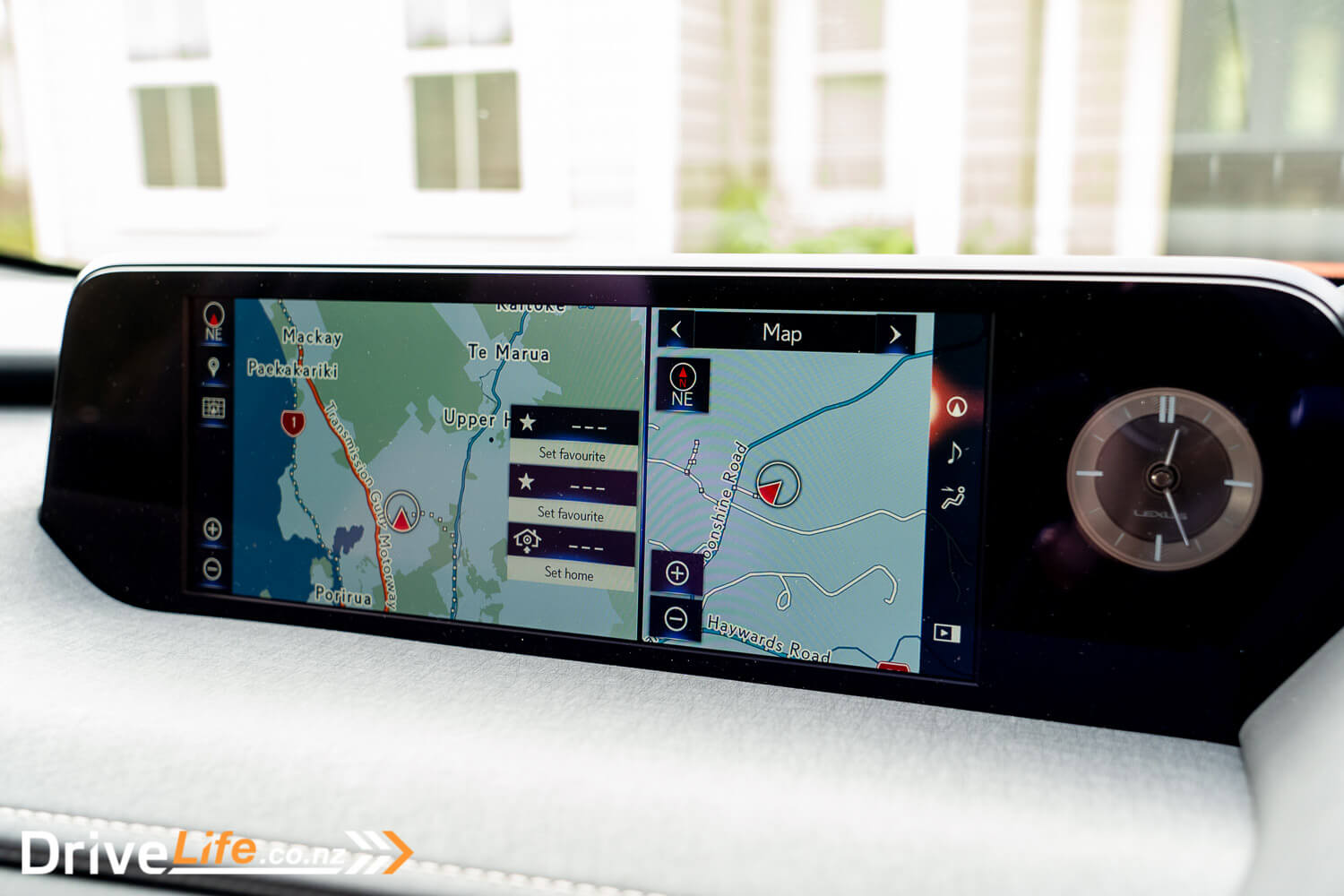
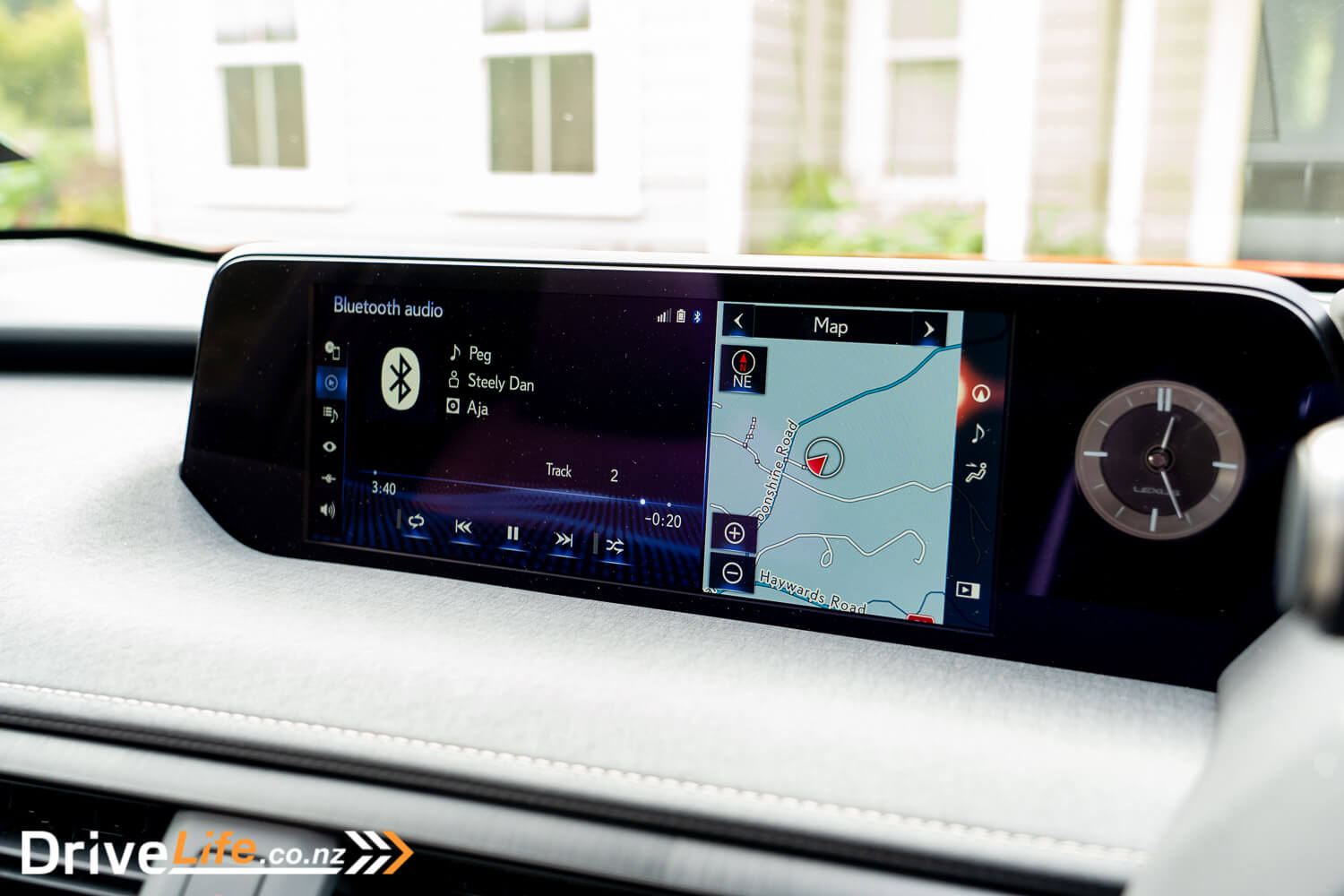
It’s much the same for the car’s energy economy. While it has a sliding bar meter to show instant energy economy, the one to show you your overall economy is a small bar that sits under the instant economy gauge. So you can’t actually give any sort of exact figures, as there’s not much room there to show any sort of detail. This all makes it feel like Lexus has somewhat rushed the product out the door.
There are two flaps on either side of the rear of the UX300e; the left side is for fast charging and the right side for plugging in your 240-volt charger at home.
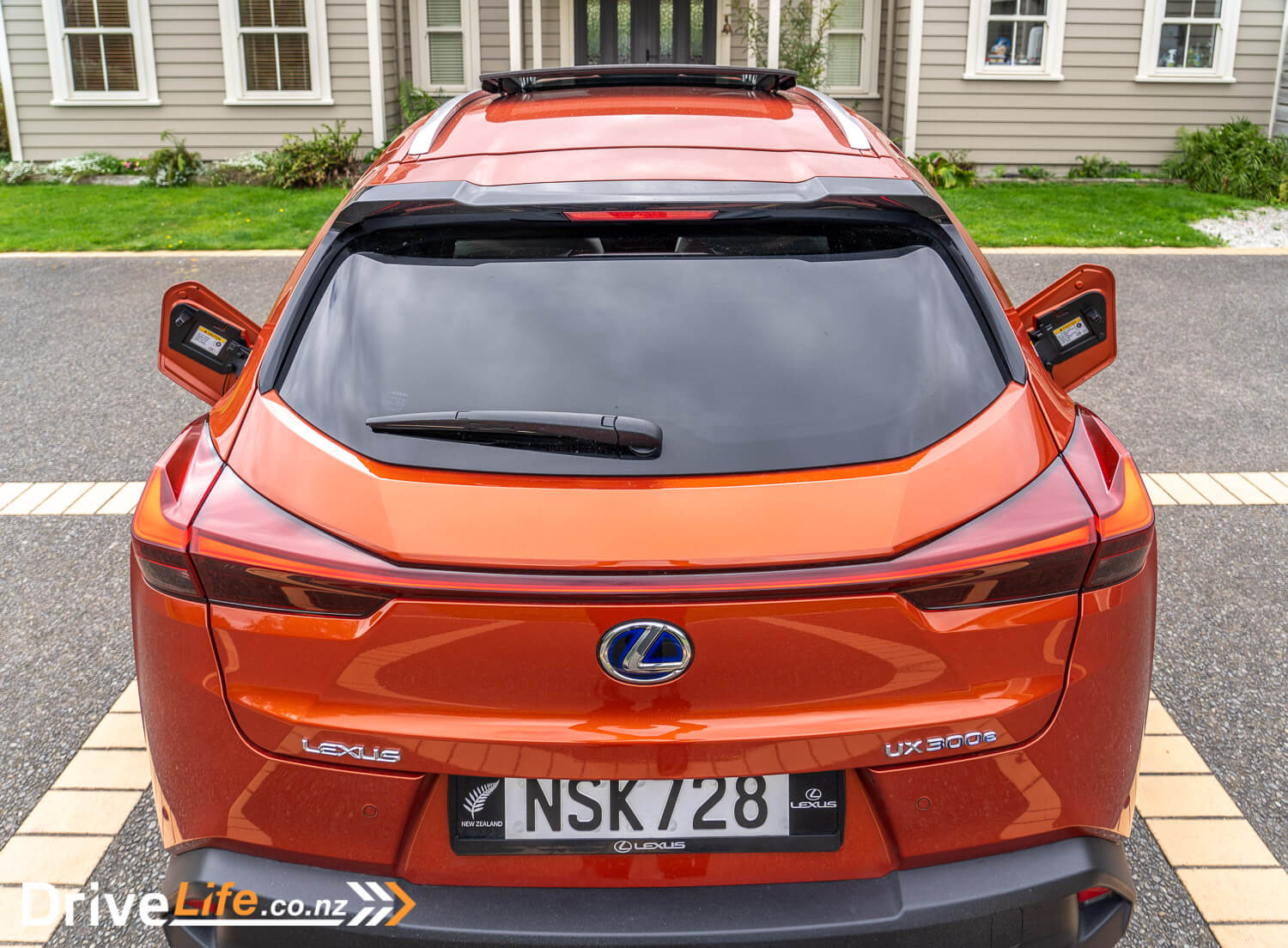
On the road again to Hawera, using adaptive cruise control all the way. It is excellent to see that the UX doesn’t have that trait that certain Toyota models do, where adaptive cruise control doesn’t brake down a hill unless someone is in front of your car. The UX300e Limited does it right, and the adaptive cruise is nicely smooth along with it. You get to pick from three different following distances, and managing this via the steering wheel controls is too easy. You can also double-tap up to increase your current adaptive cruise speed to the new (higher) limit, or double-tap down to reduce it to the current speed limit. I used this often, it’s a great way to keep those flashing blue and red lights away.
If there was one negative on the adaptive cruise on the UX300e Limited it would be that if the gear lever is in ‘B’ mode, adaptive cruise control does not work. It turns on, but you can’t set it. There’s no message on the dash that you need to take the car out of B mode to make it work. And I felt like an idiot trying it over and over, until I remembered this is how Lexus/Toyota does it. It’d be nice to have a simple message on the dash telling you why it isn’t working.
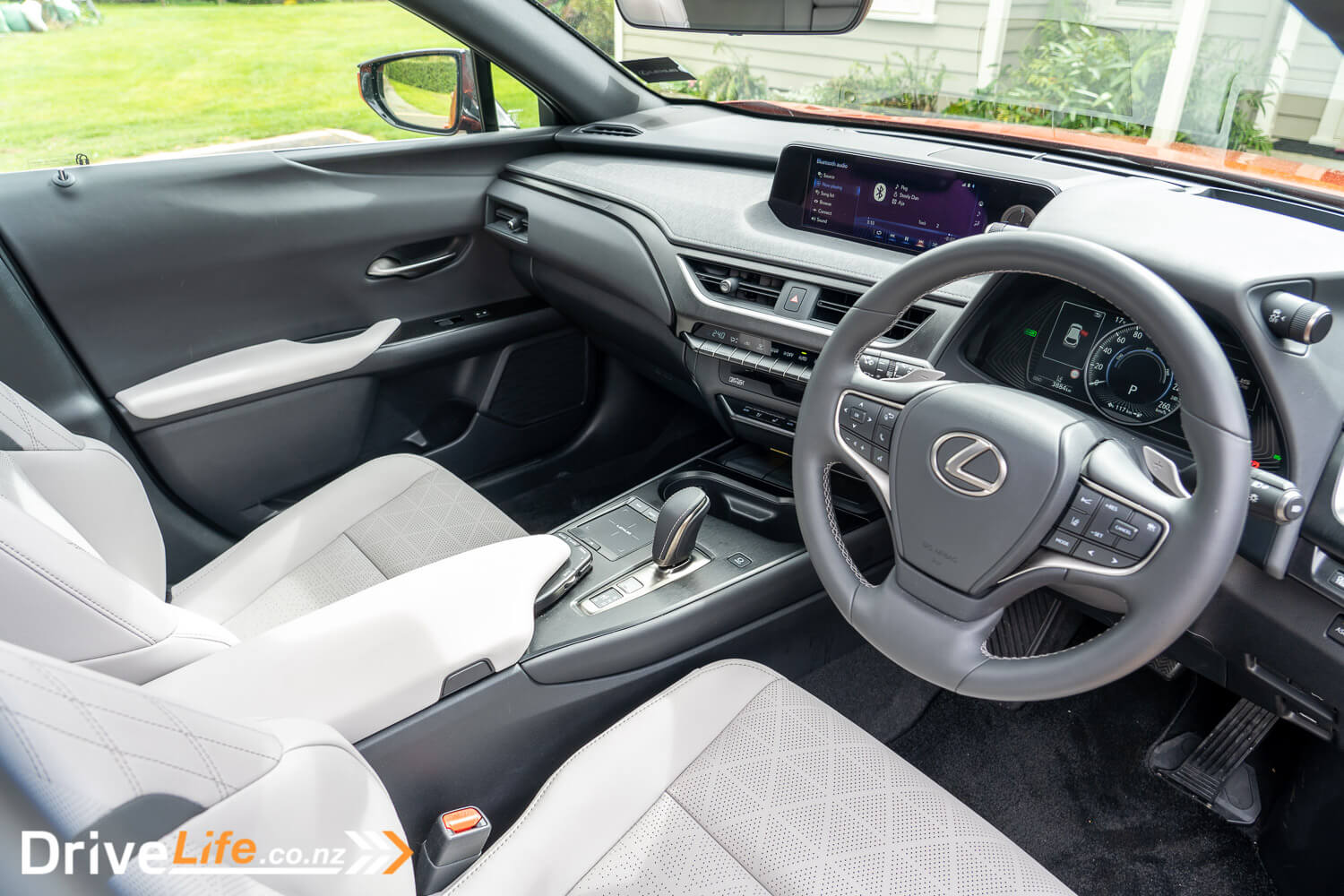
The steering wheel controls overall are very good, with a nice feel and rarely do you need to look down. I did (and still do) struggle when manufacturers like Lexus put the volume on one side of the wheel and track/station select on the other and often found my fingers going to the wrong side of the wheel, even after 1,000Km. Not the end of the world, though.
Before leaving Hawera on the Sunday, I stopped in at Pak n Save and got the battery to 70%. I knew I’d need to charge up again in Whanganui, so there was no point taking it higher. I hit the road – no rain now – and cruised back to the same Pak N Save to find a Tesla Model 3 Long Range that had just plugged in. They’d be a while, so I thought I’d have a crack at Bulls instead. I drove into Bulls with 20Km range left and plugged in. Some people might scream out “range anxiety”! but after driving so many EVs, it’s all a bit meh and I wasn’t concerned at all. Less than 20 minutes later (and a nice walk around Bulls while waiting), I easily had enough to get home.
While Lexus suggests the UX300e Limited should use around 15.0kWh/100km, at a guess our test car used 19.5kWh100Km since there’s no way of actually determining the exact figure.
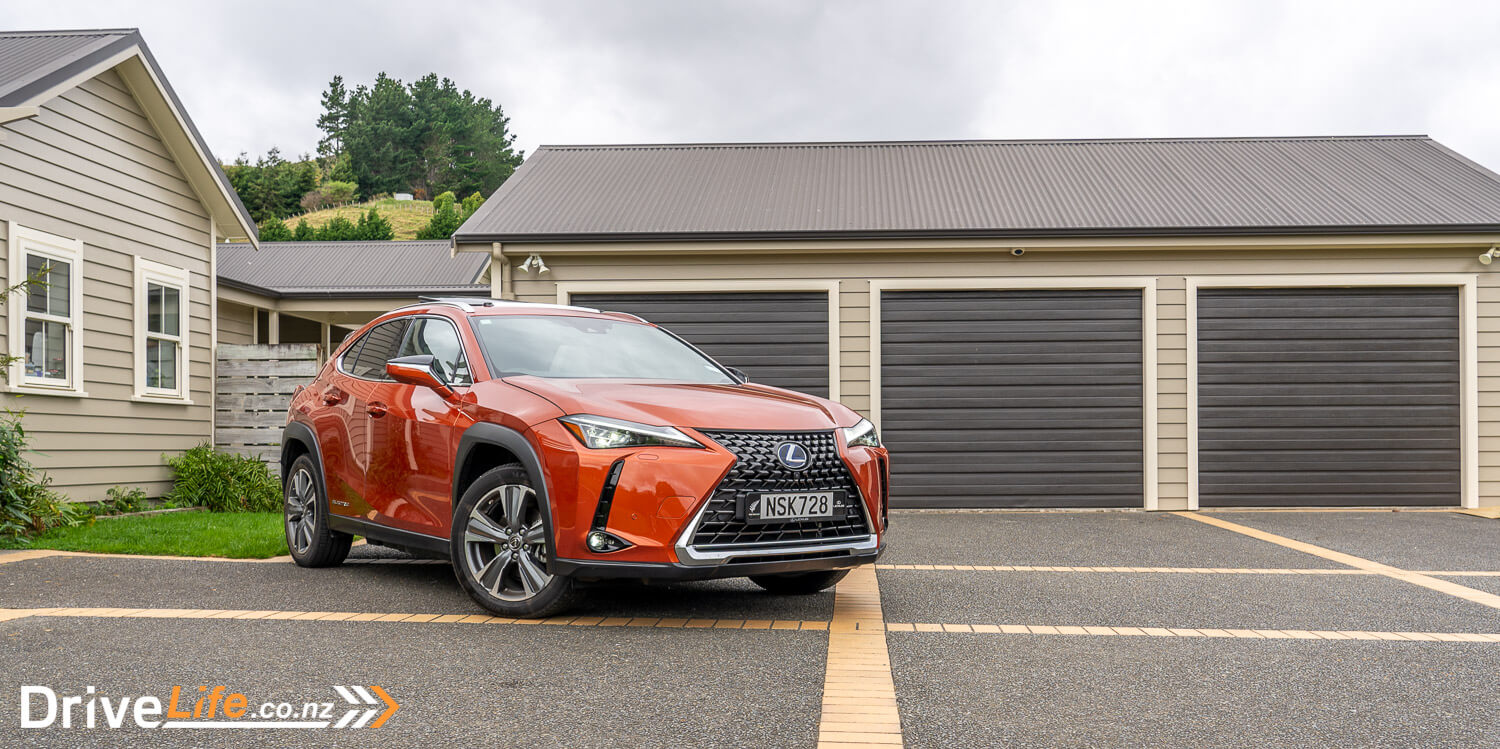
2022 Lexus UX300e Limited – Specifications
| Vehicle Type | 5-door front-wheel-drive mid-size electric SUV |
| Starting Price | $79,990 |
| Price as Tested | $79,990 |
| Engine | Single electric motor |
| Power, Torque kW/Nm | 150/300 |
| Spare Wheel | Pump only |
| Kerb Weight, Kg | 2,245 |
| Length x Width x Height mm | 4495x1840x1545 |
| Cargo Capacity, Litres (seats up/seats down) | 310/NA 310=303+7 litres underfloor storage |
| Energy Economy, kWh/100km | Advertised Spec – Combined – 15.0 Real-World Test – Combined – 19.5 (estimated) Low Usage: 6-10 / Medium Usage 11-19 / High Usage 19+ |
| Towing Capacity Kg, unbraked/braked | NA |
| Turning circle metres | 10.4 Small: 6-10m / Medium 10-12m / Large 12m+ |
| Warranty | 4 Years unlimited kilometres 4 Years Roadside Assist 4 Years service plan Battery 8 Years or 160,000Km |
| Safety information | ANCAP Rating – 5 stars – Link Rightcar.govt.nz – 5 Stars – NSK728 |
Have you enjoyed this review? Be sure to join our monthly email newsletter list so you don’t miss a single car review!


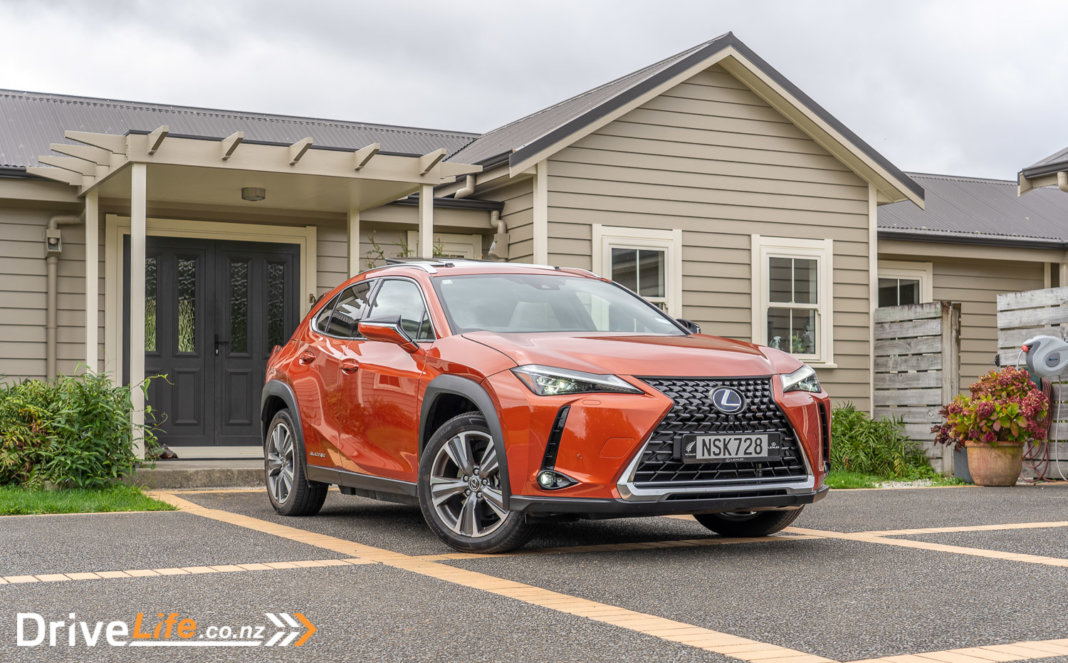






Responses from people indicate that most customers who buy expensive cars want a similar appearance. Apart from the power supply, Lexus made an excellent decision to provide the UX300e with the same look as most other UX models. Additionally, the company is unwavering in its commitment to offering early-stage adopters a complete ownership plan that will help them transition to zero-emissions driving.
Agree with your comments about the look. There seems to be two traits appearing as far as EVs go: stick as close as you can to the original design, or go way out of the box with something radical.